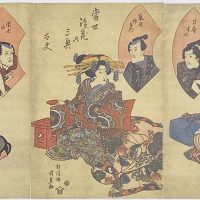-
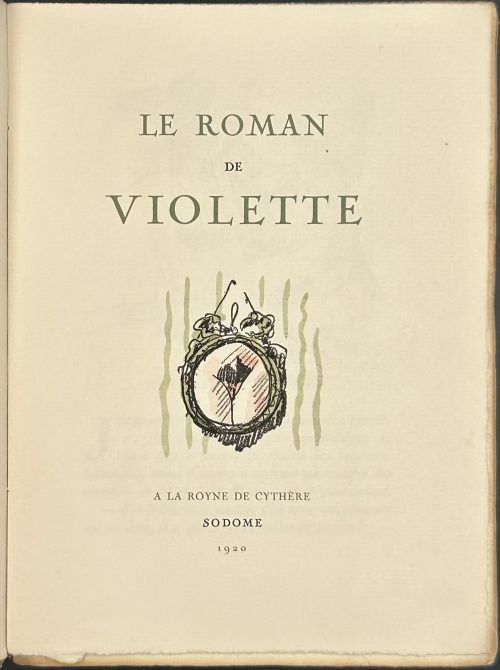 Softcover volume, 19.5 x 14.3 cm, olive French flapped wrappers, glassine dust cover, printed on laid paper (Hollande), outer and bottom margins untrimmed, some pages uncut; pagination: [2] blank, [i-iv] h.t./limit., t.p./blank, v-viii, 1-196 [197] [5], total 212 pages plus frontispiece; head- and tailpieces and in-text stencil-coloured etchings after Chéripoulos. Title-page (olive and black): LE ROMAN | DE | VIOLETTE | {vignette} | A LA ROYNE DE CYTHÈRE | SODOME | 1920 || Limitation: Cet ouvrage, achevé d'imprimer le cinq Janvier Mil Neuf Cent Vingt à trois cents exemplaires dont vingt-cinq exemplaires sur Japon Impérial contenant chacun un dessin original de Chéripoulos, numérotés de un à vingt-cinq; deux cent soixante-quinze exemplaires sur papier de Hollande, numérotés de vingt-six à trois cents; en plus cinq exemplaires de collaborateurs marqués de A à E. Le présent exemplaire porte le numéro 72. Edition: Printed on the 5th of January 1920 in 305 copies (№№ 1-25 on Japon Impérial, №№ 26-300 on Hollande, A–E for collaborators). Catalogue raisonné: Dutel III № 2339, p. 350. Contributors: Henriette de Mannoury d'Ectot [Henriette Nicolas Le Blanc] (French 1815 – 1899) Charles Auguste Edelmann [Chéripoulos] (French, 1879 – 1950).
Softcover volume, 19.5 x 14.3 cm, olive French flapped wrappers, glassine dust cover, printed on laid paper (Hollande), outer and bottom margins untrimmed, some pages uncut; pagination: [2] blank, [i-iv] h.t./limit., t.p./blank, v-viii, 1-196 [197] [5], total 212 pages plus frontispiece; head- and tailpieces and in-text stencil-coloured etchings after Chéripoulos. Title-page (olive and black): LE ROMAN | DE | VIOLETTE | {vignette} | A LA ROYNE DE CYTHÈRE | SODOME | 1920 || Limitation: Cet ouvrage, achevé d'imprimer le cinq Janvier Mil Neuf Cent Vingt à trois cents exemplaires dont vingt-cinq exemplaires sur Japon Impérial contenant chacun un dessin original de Chéripoulos, numérotés de un à vingt-cinq; deux cent soixante-quinze exemplaires sur papier de Hollande, numérotés de vingt-six à trois cents; en plus cinq exemplaires de collaborateurs marqués de A à E. Le présent exemplaire porte le numéro 72. Edition: Printed on the 5th of January 1920 in 305 copies (№№ 1-25 on Japon Impérial, №№ 26-300 on Hollande, A–E for collaborators). Catalogue raisonné: Dutel III № 2339, p. 350. Contributors: Henriette de Mannoury d'Ectot [Henriette Nicolas Le Blanc] (French 1815 – 1899) Charles Auguste Edelmann [Chéripoulos] (French, 1879 – 1950). -
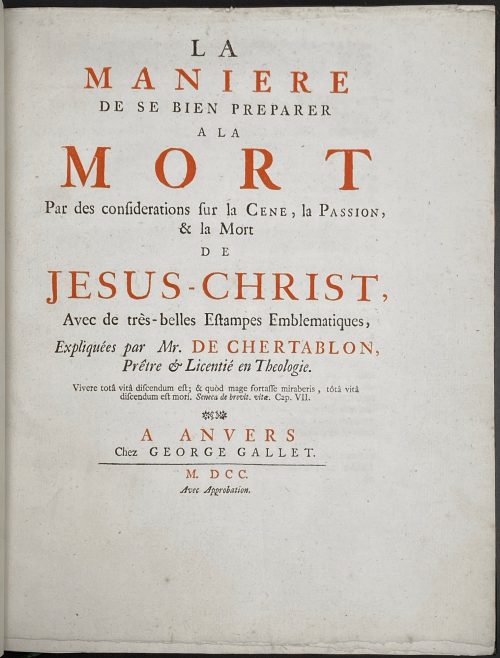 M. de Chertablon. La maniere de se bien preparer a la Mort par des Considerations sur la Cene, la Passion, et la Mort de Jesu-Christ. – Antwerp: George Gallet, 1700. Pagination: ff, [2 - blanks] [2 - t.p., blank] [3 - advert.] 4-63 [64]; 42 copper etched plates by Romeyn de Hooghe: A, B, C, 1-39; [20 - Dutch plate description of the David de la Vigne's Miroir de la bonne mort], bf. Full title: La maniere de se bien preparer a la Mort par des Considerations sur la Cene, la Passion, et la Mort de Jesu-Christ, Avec de très-belles Estampes Emblematiques, Expliquées par Mr. de Chertablon, Piêtre & Licentié en Theologie. Vivere totâ vitâ discendum est; & quòd mage fortasse miraberis, tôtâ vitâ discendum est mori. Seneca de brevit. vitæ. Cap. VII. A Anvers, Chez George Gallet. M DCC, Avec Approbation. / David de La Vigne. Spiegel om wel te sterven, annwyzende met beeltenissen van het lyden onses zaligmaakers Jesu Christi. Verzierd met 42 fyne Geërste Kopere Platen, Door Romain de Hooghe; Te Amsterdam, Voor dezen gedrukt by J. Stigter. Size: 4to, 27.2 x 21.6 cm. Binding: Late 19th century brown calf over marbled boards, spine with gilt lettering, raised bands, double fillet blind panels in compartments; marbled end-papers; bookplate of Samuel Ashton Thompson Yates library, AD 1894. Book illustrated with 42 copperplate etched engravings by Romeyn de Hooghe (Dutch, Amsterdam 1645–1708 Haarlem). According to Bonhams: the plates were "first printed for David de la Vigne's Miroir de la bonne mort. Each of the plates depicts a man contemplating a religious image in order to ease the passing of death, accompanied by commentary and an appropriate verse of scripture for each plate. The present French edition is bound with, as issued, the Dutch translation of David de La Vigne's aforementioned work."
M. de Chertablon. La maniere de se bien preparer a la Mort par des Considerations sur la Cene, la Passion, et la Mort de Jesu-Christ. – Antwerp: George Gallet, 1700. Pagination: ff, [2 - blanks] [2 - t.p., blank] [3 - advert.] 4-63 [64]; 42 copper etched plates by Romeyn de Hooghe: A, B, C, 1-39; [20 - Dutch plate description of the David de la Vigne's Miroir de la bonne mort], bf. Full title: La maniere de se bien preparer a la Mort par des Considerations sur la Cene, la Passion, et la Mort de Jesu-Christ, Avec de très-belles Estampes Emblematiques, Expliquées par Mr. de Chertablon, Piêtre & Licentié en Theologie. Vivere totâ vitâ discendum est; & quòd mage fortasse miraberis, tôtâ vitâ discendum est mori. Seneca de brevit. vitæ. Cap. VII. A Anvers, Chez George Gallet. M DCC, Avec Approbation. / David de La Vigne. Spiegel om wel te sterven, annwyzende met beeltenissen van het lyden onses zaligmaakers Jesu Christi. Verzierd met 42 fyne Geërste Kopere Platen, Door Romain de Hooghe; Te Amsterdam, Voor dezen gedrukt by J. Stigter. Size: 4to, 27.2 x 21.6 cm. Binding: Late 19th century brown calf over marbled boards, spine with gilt lettering, raised bands, double fillet blind panels in compartments; marbled end-papers; bookplate of Samuel Ashton Thompson Yates library, AD 1894. Book illustrated with 42 copperplate etched engravings by Romeyn de Hooghe (Dutch, Amsterdam 1645–1708 Haarlem). According to Bonhams: the plates were "first printed for David de la Vigne's Miroir de la bonne mort. Each of the plates depicts a man contemplating a religious image in order to ease the passing of death, accompanied by commentary and an appropriate verse of scripture for each plate. The present French edition is bound with, as issued, the Dutch translation of David de La Vigne's aforementioned work." -
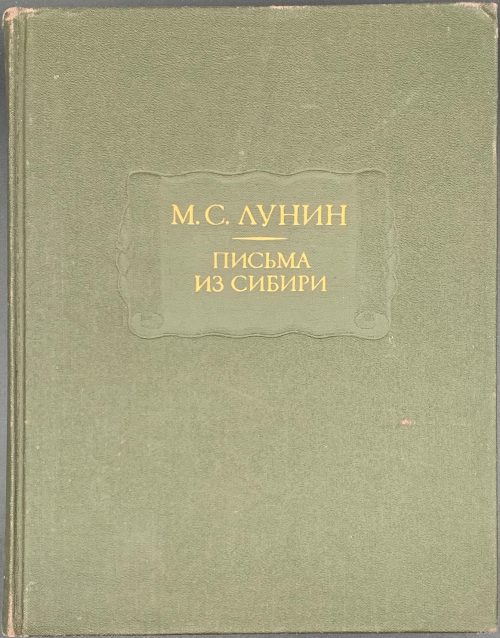 Title (black and red): М. С. ЛУНИН | — | ПИСЬМА ИЗ СИБИРИ | — | Издание подготовили | И. А. Желвакова и Н. Я Эйдельман | МОСКВА | «НАУКА» | 1987 || Pagination: [1, 2] Serial h.t. / blank, [3, 4] t.p. / imprint, [5] 6-492 [4], 1 portrait and 8 leaves of plates. Collation: 16mo; [1]16 216 38 (plates), 4-1716. Binding: serial green buckram blind-stamped with a scroll adorned with gold lettering to board and spine.
Title (black and red): М. С. ЛУНИН | — | ПИСЬМА ИЗ СИБИРИ | — | Издание подготовили | И. А. Желвакова и Н. Я Эйдельман | МОСКВА | «НАУКА» | 1987 || Pagination: [1, 2] Serial h.t. / blank, [3, 4] t.p. / imprint, [5] 6-492 [4], 1 portrait and 8 leaves of plates. Collation: 16mo; [1]16 216 38 (plates), 4-1716. Binding: serial green buckram blind-stamped with a scroll adorned with gold lettering to board and spine. -
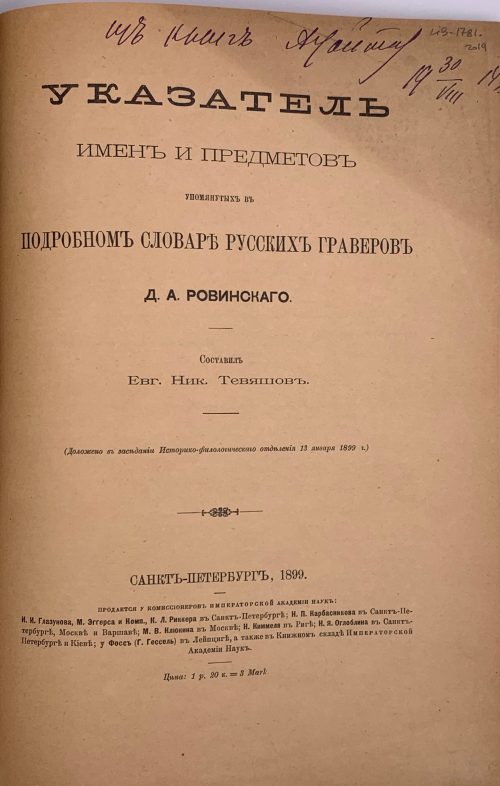 УКАЗАТЕЛЬ | ИМЕНЪ И ПРЕДМЕТОВЪ | УПОМЯНУТЫХЪ ВЪ | ПОДРОБНОМЪ СЛОВАРЕѢ РУССКИХЪ ГРАВЕРОВЪ Д. А. РОВИНСКАГО. | СОСТАВИЛЪ | ЕВГ. НИК. ТЕВЯШОВЪ. | (Доложено въ заседанiи Историко-филологическаго отделенiя 13 января 1899 г.) | САНКТЪ-ПЕТЕРБУРГЪ, 1899. | ПРОДАЕТСЯ У КОМИССIОНЕРОВЪ ИМПЕРАТОРСКОЙ АКАДЕМИИ НАУКЪ: | И. И. Глазунова, М. Эггерса и Комп., К. Л. Риккера въ Санктъ-Петербургѣ; Н. П. Карбасникова въ Санктъ-Пе- | тербургѣ, Москвѣ и Варшавѣ; | М. В. Клюкина въ Москве; Н. Киммеля въ Ригѣ; Н. Я. Оглоблина въ Санктъ- | Петербургѣ и Кiевѣ; у Фоссъ (Г. Гэссель) въ Лейпцигѣ, а также въ Книжномъ складѣ Императорской | академiи наукъ. | Цена: 1 р. 20 к. = 3 Mark. Pagination: original wrapper bound in, [2] t.p. / colophon, [1, 2] 3-208 (numbered half-pages, 52 leaves). Collation: 4to; 1-134. Binding: Owner's later 3/4 grey cloth over buckram boards. original front wrapper preserved, upper-right corner cut out.
УКАЗАТЕЛЬ | ИМЕНЪ И ПРЕДМЕТОВЪ | УПОМЯНУТЫХЪ ВЪ | ПОДРОБНОМЪ СЛОВАРЕѢ РУССКИХЪ ГРАВЕРОВЪ Д. А. РОВИНСКАГО. | СОСТАВИЛЪ | ЕВГ. НИК. ТЕВЯШОВЪ. | (Доложено въ заседанiи Историко-филологическаго отделенiя 13 января 1899 г.) | САНКТЪ-ПЕТЕРБУРГЪ, 1899. | ПРОДАЕТСЯ У КОМИССIОНЕРОВЪ ИМПЕРАТОРСКОЙ АКАДЕМИИ НАУКЪ: | И. И. Глазунова, М. Эггерса и Комп., К. Л. Риккера въ Санктъ-Петербургѣ; Н. П. Карбасникова въ Санктъ-Пе- | тербургѣ, Москвѣ и Варшавѣ; | М. В. Клюкина въ Москве; Н. Киммеля въ Ригѣ; Н. Я. Оглоблина въ Санктъ- | Петербургѣ и Кiевѣ; у Фоссъ (Г. Гэссель) въ Лейпцигѣ, а также въ Книжномъ складѣ Императорской | академiи наукъ. | Цена: 1 р. 20 к. = 3 Mark. Pagination: original wrapper bound in, [2] t.p. / colophon, [1, 2] 3-208 (numbered half-pages, 52 leaves). Collation: 4to; 1-134. Binding: Owner's later 3/4 grey cloth over buckram boards. original front wrapper preserved, upper-right corner cut out. -
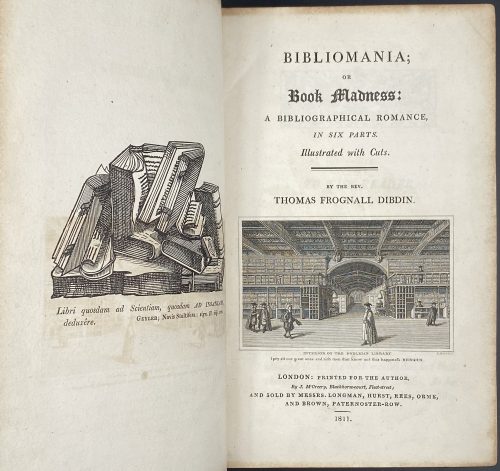 Title: BIBLIOMANIA; | OR | Book Madness: | A BIBLIOGRAPHICAL ROMANCE, | IN SIX PARTS. | Illustrated with Cuts. | BY THE REV. | THOMAS FROGNALL DIBDIN. | {vignette} | INTERIOR OF THE BODLEIAN LIBRARY | I pity all our great ones and rich men that know not this happiness. HEINSIUS. | LONDON: PRINTED FOR THE AUTHOR, | By J. McCreery, Blackhorse-court, Fleet-street; | AND SOLD BY MESSRS. LONGMAN, HURST, REES, ORME, | AND BROWN, PATERNOSTER-ROW. | 1811.|| Pagination: ffl, [i, ii] - ht, frontis., [iii, iv] - t.p., blank, [v]vi-ix - to the reader, [x] - blank, [2] - contents, [1, 2] - part 1 fl. t.p., blank, [3] - woodcut frame and capital I, 4-782 (imprint to p. 782) [2] - errata, blank, bfl; 1 plate op. p. 158. Collation: [A]6 B-Z8 2A-2Z8, 3A-3B8, 3C-3F4. Binding: 8vo, 23 x 14 cm, modern full dark brown calf by Period Binders (Bath, England), gilt fillet border to boards, raised bands with gilt ornaments and lettering to spine, pp. 685-688 an open tear in upper 1/8 of lateral margin, all margins marbled. Substantially revised 1st edition ("so much altered and enlarged, as to assume the character of a new work"). Author: Thomas Frognall Dibdin (British, 1776 – 1847).
Title: BIBLIOMANIA; | OR | Book Madness: | A BIBLIOGRAPHICAL ROMANCE, | IN SIX PARTS. | Illustrated with Cuts. | BY THE REV. | THOMAS FROGNALL DIBDIN. | {vignette} | INTERIOR OF THE BODLEIAN LIBRARY | I pity all our great ones and rich men that know not this happiness. HEINSIUS. | LONDON: PRINTED FOR THE AUTHOR, | By J. McCreery, Blackhorse-court, Fleet-street; | AND SOLD BY MESSRS. LONGMAN, HURST, REES, ORME, | AND BROWN, PATERNOSTER-ROW. | 1811.|| Pagination: ffl, [i, ii] - ht, frontis., [iii, iv] - t.p., blank, [v]vi-ix - to the reader, [x] - blank, [2] - contents, [1, 2] - part 1 fl. t.p., blank, [3] - woodcut frame and capital I, 4-782 (imprint to p. 782) [2] - errata, blank, bfl; 1 plate op. p. 158. Collation: [A]6 B-Z8 2A-2Z8, 3A-3B8, 3C-3F4. Binding: 8vo, 23 x 14 cm, modern full dark brown calf by Period Binders (Bath, England), gilt fillet border to boards, raised bands with gilt ornaments and lettering to spine, pp. 685-688 an open tear in upper 1/8 of lateral margin, all margins marbled. Substantially revised 1st edition ("so much altered and enlarged, as to assume the character of a new work"). Author: Thomas Frognall Dibdin (British, 1776 – 1847). -
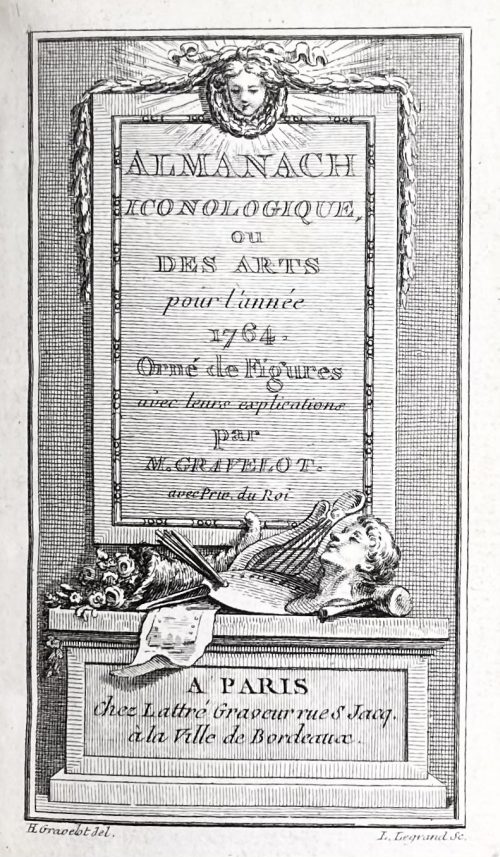
Engraved title:
Upper frame: ALMANACH | ICONOLOGIQUE, | OU | DES ARTS | pour l'année | 1764. | Orné de Figures | avec leurs explications | par | M. GRAVELOT. | avec Priv. du Roy | A PARIS
Lower frame: Chez Lattré Graveur rue S. Jacq. | à la Ville de Bordeaux.
Under the frame: H. Gravelot del. — L. Legrand sc.
28 leaves, of them: engraved t.p., engraved frontis., and 12 plates, text engraved. Pages numbered 1-12, and I-XII (incorrectly marked XVI), other unpaginated, unbound tissue guards. Size: 10.6 x 7.2 cm, full polished crimson calf w/veins, triple-ruled in gilt with florets in corners, flat spine, double-ruled in gilt, all edges gilt. Florets in compartments, black title label with gilt lettering “ALM | ICON ||”, peacock marbled endpapers, blue silk ribbon. Approbation dated 15 November 1763, as some plates.
Catalogue raisonné: Cohen, De Ricci 454.
-
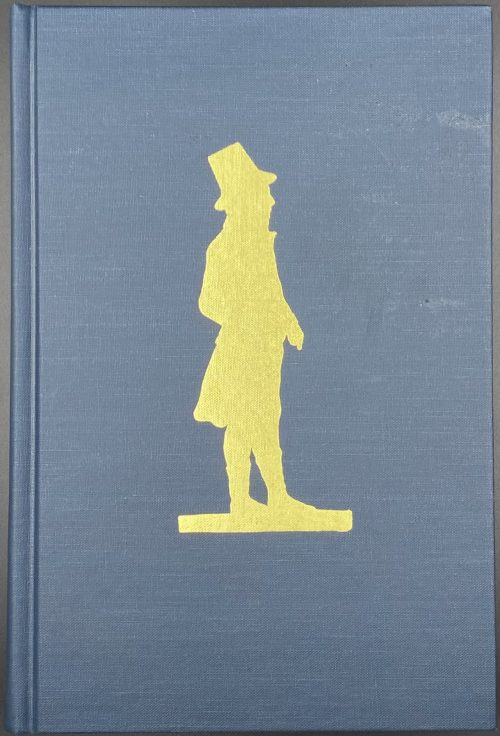 Title: THOMAS FROGNALL DIBDIN | 1776-1847 | A Bibliography | By John Windle and Karma Pippin | Oak Knoll Press | New Castle Delaware | 1999 || Pagination: [2 blanks] [i, ii] – standing silhouette / frontis. with buste portrait 1821 (misspelled "Didbin"), [iii, iv] – t.p. / colophon, [v, vi] – dedication / blank, [vii, viii] – contents / blank, [ix, x] – illustr. / portrait 1816, [xi] xii-xxiii [xxiv] [1] 2-284 [2]. Binding: 23.5 x 16 cm, hardcover, publisher’s blue cloth gilt-stamped with a standing silhouette of T. F. Dibdin to cover, gilt lettering to spine.
Title: THOMAS FROGNALL DIBDIN | 1776-1847 | A Bibliography | By John Windle and Karma Pippin | Oak Knoll Press | New Castle Delaware | 1999 || Pagination: [2 blanks] [i, ii] – standing silhouette / frontis. with buste portrait 1821 (misspelled "Didbin"), [iii, iv] – t.p. / colophon, [v, vi] – dedication / blank, [vii, viii] – contents / blank, [ix, x] – illustr. / portrait 1816, [xi] xii-xxiii [xxiv] [1] 2-284 [2]. Binding: 23.5 x 16 cm, hardcover, publisher’s blue cloth gilt-stamped with a standing silhouette of T. F. Dibdin to cover, gilt lettering to spine. -
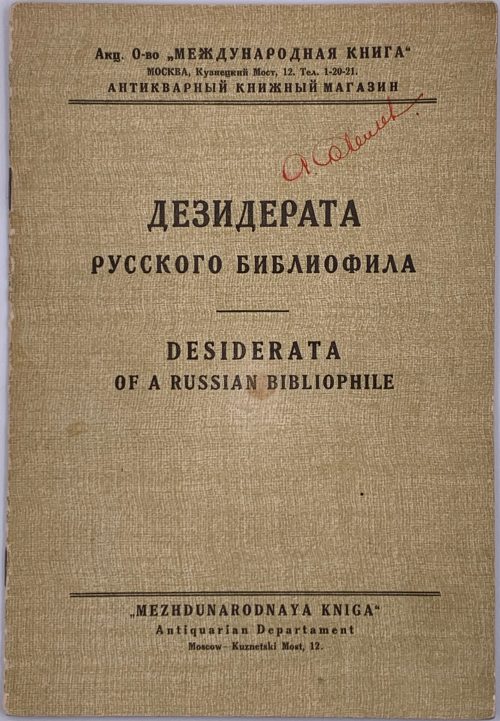 Cover: Акц. О-во “МЕЖДУНАРОДНАЯ КНИГА” | МОСКВА, Кузнецкий Мост, 12. Тел. 1-20-21. | АНТИКВАРНЫЙ КНИЖНЫЙ МАГАЗИН | ДЕЗИДЕРАТА | РУССКОГО БИБЛИОФИЛА | DESIDERATA OF A RUSSIAN BIBLIOPHILE | MEZHDUNARODNAYA KNIGA | Antiquarian Departament | Moscow — Kuznetski Most, 12. || Title: DESIDERATA | РУССКОГО БИБЛИОФИЛА | РЕДЧАЙШИЕ КНИГИ И ИХ | СОВРЕМЕННАЯ РАСЦЕНКА | СОСТАВИЛ П. П. ШИБАНОВ | (К ДОКЛАДУ В РУССКОМ ОБЩЕСТВЕ | ДРУЗЕЙ КНИГИ 15 АПРЕЛЯ 1927 Г.) | МОСКВА — 1927 || Title verso: Корректурное издание в количестве 200 нумерованных экземпляров, из которых №№ 1–100 для членов Русского Общества Друзей Книгию Отпечатано в 13-й типографии Мосполиграф «Мысль Печатника» Главлит №85566. № 121. Back cover: "Не для продажи". Publisher’s lettered wrappers, 21.5 x 15 cm, pagination: [1-4] 5-15 [16 blank]; stamps and inscriptions to covers, markings inside. Limited edition of 200 copies, of which this copy is № 121. Шибанов, Павел Петрович (Russian, 1864 – 1935).
Cover: Акц. О-во “МЕЖДУНАРОДНАЯ КНИГА” | МОСКВА, Кузнецкий Мост, 12. Тел. 1-20-21. | АНТИКВАРНЫЙ КНИЖНЫЙ МАГАЗИН | ДЕЗИДЕРАТА | РУССКОГО БИБЛИОФИЛА | DESIDERATA OF A RUSSIAN BIBLIOPHILE | MEZHDUNARODNAYA KNIGA | Antiquarian Departament | Moscow — Kuznetski Most, 12. || Title: DESIDERATA | РУССКОГО БИБЛИОФИЛА | РЕДЧАЙШИЕ КНИГИ И ИХ | СОВРЕМЕННАЯ РАСЦЕНКА | СОСТАВИЛ П. П. ШИБАНОВ | (К ДОКЛАДУ В РУССКОМ ОБЩЕСТВЕ | ДРУЗЕЙ КНИГИ 15 АПРЕЛЯ 1927 Г.) | МОСКВА — 1927 || Title verso: Корректурное издание в количестве 200 нумерованных экземпляров, из которых №№ 1–100 для членов Русского Общества Друзей Книгию Отпечатано в 13-й типографии Мосполиграф «Мысль Печатника» Главлит №85566. № 121. Back cover: "Не для продажи". Publisher’s lettered wrappers, 21.5 x 15 cm, pagination: [1-4] 5-15 [16 blank]; stamps and inscriptions to covers, markings inside. Limited edition of 200 copies, of which this copy is № 121. Шибанов, Павел Петрович (Russian, 1864 – 1935). -
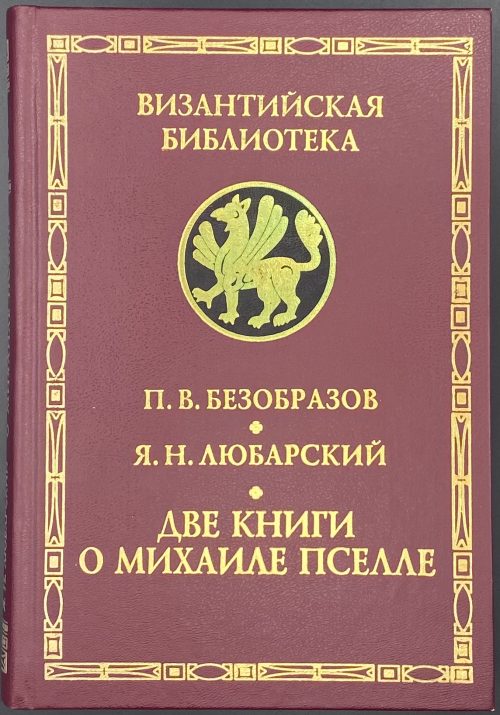 Title: П. В. БЕЗОБРАЗОВ | Я. Н. ЛЮБАРСКИЙ | ВИЗАНТИЙСКИЙ ПИСАТЕЛЬ | И ГОСУДАРСТВЕННЫЙ ДЕЯТЕЛЬ | МИХАИЛ ПСЕЛЛ | МИХАИЛ ПСЕЛЛ: | ЛИЧНОСТЬ И ТВОРЧЕСТВО | Научное издание | Издательство | «АЛЕТЕЙЯ» | Санкт-Петербург | 2001 || Pagination: [1-5] 6-542 [2]. Binding: 21.5 x 15 cm; hardcover, crimson buckram, gilt lettering in the border, gilt serial device on black, pictorial endpapers. Print run: 1,300 copies. ISBN: 5-89329-401-7 Безобразов, Павел Владимирович (Russian, 1859 – 1918). Любарский, Яков Николаевич (Russian, 1929 – 2003).
Title: П. В. БЕЗОБРАЗОВ | Я. Н. ЛЮБАРСКИЙ | ВИЗАНТИЙСКИЙ ПИСАТЕЛЬ | И ГОСУДАРСТВЕННЫЙ ДЕЯТЕЛЬ | МИХАИЛ ПСЕЛЛ | МИХАИЛ ПСЕЛЛ: | ЛИЧНОСТЬ И ТВОРЧЕСТВО | Научное издание | Издательство | «АЛЕТЕЙЯ» | Санкт-Петербург | 2001 || Pagination: [1-5] 6-542 [2]. Binding: 21.5 x 15 cm; hardcover, crimson buckram, gilt lettering in the border, gilt serial device on black, pictorial endpapers. Print run: 1,300 copies. ISBN: 5-89329-401-7 Безобразов, Павел Владимирович (Russian, 1859 – 1918). Любарский, Яков Николаевич (Russian, 1929 – 2003). -
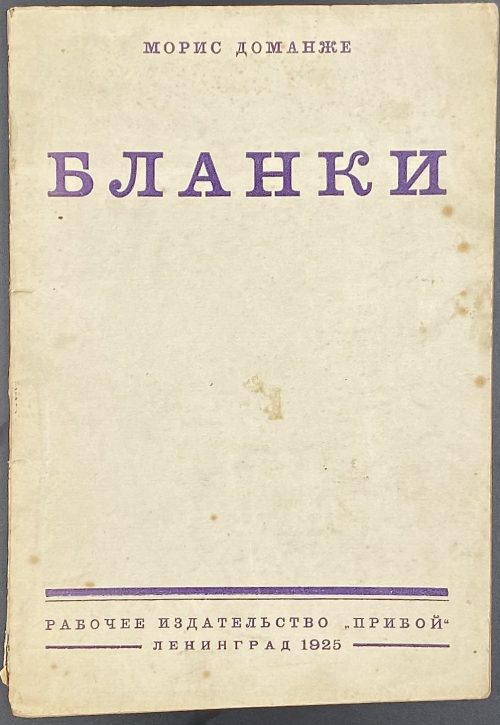 Cover: МОРИС ДОМАНЖЕ | БЛАНКИ | РАБОЧЕЕ ИЗДАТЕЛЬСТВО “ПРИБОЙ” | ЛЕНИНГРАД 1925 || Title page: МОРИС ДОМАНЖЕ | БЛАНКИ | Пер. с французского | Рабочее Издательство “ПРИБОЙ” | Ленинград 1925 || Pagination: [2] 3-97 [3]. Collation: 8vo; [1]8 2-68 [7]2, total 50 leaves. Binding: Publisher’s wrappers, lettering to covers and spine, uncut. Contributor: Maurice Dommanget (French, 1888 – 1976) – author. Translation of: Blanqui par Maurice Dommanget. — Paris: Librairie de l'Humanité, 1924.
Cover: МОРИС ДОМАНЖЕ | БЛАНКИ | РАБОЧЕЕ ИЗДАТЕЛЬСТВО “ПРИБОЙ” | ЛЕНИНГРАД 1925 || Title page: МОРИС ДОМАНЖЕ | БЛАНКИ | Пер. с французского | Рабочее Издательство “ПРИБОЙ” | Ленинград 1925 || Pagination: [2] 3-97 [3]. Collation: 8vo; [1]8 2-68 [7]2, total 50 leaves. Binding: Publisher’s wrappers, lettering to covers and spine, uncut. Contributor: Maurice Dommanget (French, 1888 – 1976) – author. Translation of: Blanqui par Maurice Dommanget. — Paris: Librairie de l'Humanité, 1924. -
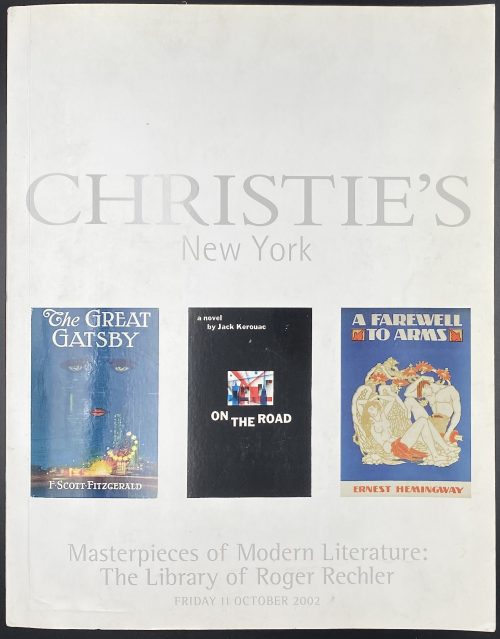 Publisher’s pictorial wrappers: CHRISTIE'S | NEW YORK | {three book covers} | Masterpieces of Modern Literature: | The Library of Roger Rechler | FRIDAY 11 OCTOBER 2002 || Red spine with white lettering from top to bottom, multiple illustrations in colour, 26.8 x 21 x 3 cm. Pagination: [1-4] 5-451 [452]. 375 lots, prices realized handwritten next to each lot and on 6 loose leaves inserted.
Publisher’s pictorial wrappers: CHRISTIE'S | NEW YORK | {three book covers} | Masterpieces of Modern Literature: | The Library of Roger Rechler | FRIDAY 11 OCTOBER 2002 || Red spine with white lettering from top to bottom, multiple illustrations in colour, 26.8 x 21 x 3 cm. Pagination: [1-4] 5-451 [452]. 375 lots, prices realized handwritten next to each lot and on 6 loose leaves inserted. -
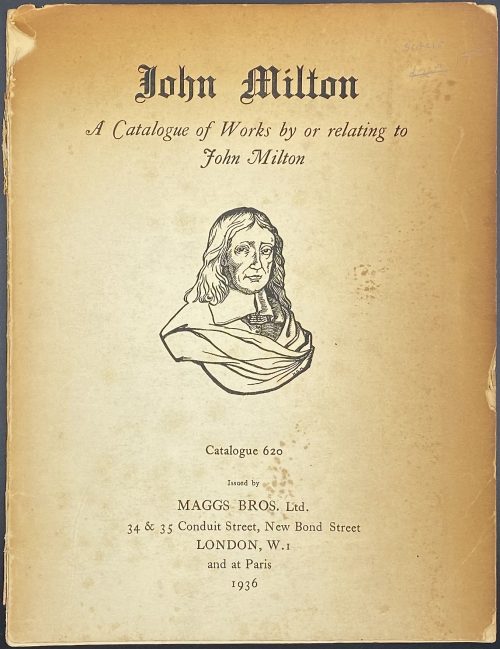 Cover: John Milton | A Catalogue of Works by or Relating to | John Milton | {vignette portrait} | Catalogue 620 | Issued by | MAGGS BROS. Ltd. | 34 & 35 Conduit Street, New Bond Street | LONDON, W.I. | and at Paris | 1936 || Title page: top left: Catalogue 620; top right: 1936, middle: JOHN MILTON | A CATALOGUE OF WORKS BY OR | RELATING TO JOHN MILTON | Largely comprising the Library of the well-known Milton Scholar, the late | prof. Hugh C. H. Candy, B.A., B Sc. | {coat of arms: by appointment to his majesty King George V} | MAGGS BROS. Ltd. | BOOKSELLERS BY APPOINTMENT TO HIS MAJESTY KING GEORGE V | AND H.R.H. THE PRINCE OF WALES | 34 & 35 CONDUIT STREET, LONDON, W.I. | TELEGRAPHIC & CABLE ADDRESS: “BIBLIOLITE, LONDON.” […] TEL.: REGENT 1337 | At Paris: Maggs Bros., 93 & 95 Rue La Boëtie. || Printed: Courier Press Leamington SPA and London. Pagination: [1-4] 5-56 [6], wrappers incl. in pagination, the total number of leaves is 31. Binding: 24 x 18.5 cm, publisher’s tan wrappers, front wrapper detached, browned.
Cover: John Milton | A Catalogue of Works by or Relating to | John Milton | {vignette portrait} | Catalogue 620 | Issued by | MAGGS BROS. Ltd. | 34 & 35 Conduit Street, New Bond Street | LONDON, W.I. | and at Paris | 1936 || Title page: top left: Catalogue 620; top right: 1936, middle: JOHN MILTON | A CATALOGUE OF WORKS BY OR | RELATING TO JOHN MILTON | Largely comprising the Library of the well-known Milton Scholar, the late | prof. Hugh C. H. Candy, B.A., B Sc. | {coat of arms: by appointment to his majesty King George V} | MAGGS BROS. Ltd. | BOOKSELLERS BY APPOINTMENT TO HIS MAJESTY KING GEORGE V | AND H.R.H. THE PRINCE OF WALES | 34 & 35 CONDUIT STREET, LONDON, W.I. | TELEGRAPHIC & CABLE ADDRESS: “BIBLIOLITE, LONDON.” […] TEL.: REGENT 1337 | At Paris: Maggs Bros., 93 & 95 Rue La Boëtie. || Printed: Courier Press Leamington SPA and London. Pagination: [1-4] 5-56 [6], wrappers incl. in pagination, the total number of leaves is 31. Binding: 24 x 18.5 cm, publisher’s tan wrappers, front wrapper detached, browned. -
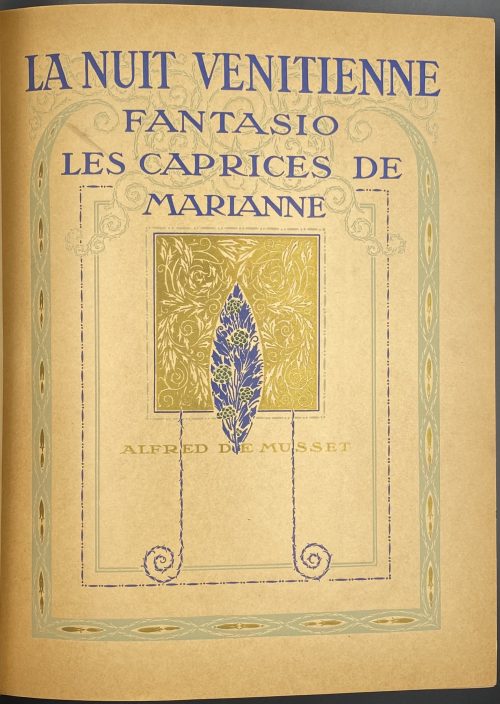 Collation: Prelims (pp.1-6): Blank leaf, front wrapper (ornamental, gilt and colour): LA NUIT VENITIENNE | FANTASIO | LES CAPRICES DE | MARIANNE | ALFRED DE MUSSET ||, blank leaf, [2] – h.t.: LA | NUIT VENITIENNE ||, [2] – t.p. (ornamental frame, marigold and reseda green): ALFRED DE MUSSET | LA NUIT | VENITIENNE | FANTASIA | LES CAPRICES | DE MARIANNE | ILLUSTRATIONS | DE | U. BRUNELLESCHI | L’EDITION D’ART H.PIAZZA | PARIS ||, [2] – ornamental divisional title: LA NUIT VENITIENNE ||, 7-138 [139/40] – contents / list of ills., [141-2] – limitation / colophon, blank leaf, back wrapper, blank leaf; plus 20 stencil-coloured (au pochoir) plates after gouaches by Umberto Brunelleschi, incl. frontispiece with red-lettered tissue guards; two more divisional titles, three headpieces in black; text printed on heavy wove paper, in an ornamental frame. Edition: 1st; limited to 500 copies on laid paper (papier du Japon) signed by the artist; this copy on wove paper without signatures, without limitation. Printed in Paris on the 10th of November 1913. Binding: 30 x 24 cm, owner’s green bead-grain buckram with a gilt-lettered black label to spine LA NUIT | VENITIENNE, publisher’s wrappers bound in, green and gilt endpapers. Alfred de Musset (French, 1810 – 1857) – author. Umberto Brunelleschi (Italian, 1879 – 1949) – artist. L’Edition d’art H. Piazza; Henri Jules Piazza (Italian, 1861 – 1929) – publisher, printer.
Collation: Prelims (pp.1-6): Blank leaf, front wrapper (ornamental, gilt and colour): LA NUIT VENITIENNE | FANTASIO | LES CAPRICES DE | MARIANNE | ALFRED DE MUSSET ||, blank leaf, [2] – h.t.: LA | NUIT VENITIENNE ||, [2] – t.p. (ornamental frame, marigold and reseda green): ALFRED DE MUSSET | LA NUIT | VENITIENNE | FANTASIA | LES CAPRICES | DE MARIANNE | ILLUSTRATIONS | DE | U. BRUNELLESCHI | L’EDITION D’ART H.PIAZZA | PARIS ||, [2] – ornamental divisional title: LA NUIT VENITIENNE ||, 7-138 [139/40] – contents / list of ills., [141-2] – limitation / colophon, blank leaf, back wrapper, blank leaf; plus 20 stencil-coloured (au pochoir) plates after gouaches by Umberto Brunelleschi, incl. frontispiece with red-lettered tissue guards; two more divisional titles, three headpieces in black; text printed on heavy wove paper, in an ornamental frame. Edition: 1st; limited to 500 copies on laid paper (papier du Japon) signed by the artist; this copy on wove paper without signatures, without limitation. Printed in Paris on the 10th of November 1913. Binding: 30 x 24 cm, owner’s green bead-grain buckram with a gilt-lettered black label to spine LA NUIT | VENITIENNE, publisher’s wrappers bound in, green and gilt endpapers. Alfred de Musset (French, 1810 – 1857) – author. Umberto Brunelleschi (Italian, 1879 – 1949) – artist. L’Edition d’art H. Piazza; Henri Jules Piazza (Italian, 1861 – 1929) – publisher, printer. -
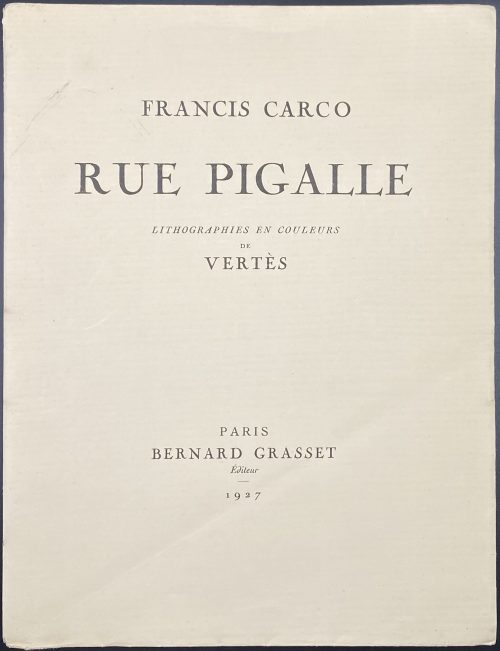 Title-page: FRANCIS CARCO | RUE PIGALLE | LITHOGRAPHIES EN COULEURS | DE | VERTÈS | PARIS | BERNARD GRASSET | Éditeur | 1927 || Description: 25.7 x 19.5 cm, French flapped cream wrappers with black lettering similar to title, lettering to spine, [2] 1st blank leaf, [2] h.t. / blank, plate / blank, [2] t.p. /blank, dedication “A | FRED ANTOINE ANGERMAYER” / blank, [1-2] d.t.p. “CHAPITRE | PREMIER” / blank, [3] 4-124, [2] limitation / blank, [2] last blank leaf; collation: 4to; π4 1-164; total 68 leaves and 14 plates printed by Frères Mourlot after watercolours by Marcel Vertès. Printing : September 15, 1927 by Coulouma in Argenteuil (H. Barthélemy, director); plates printed by Frères Mourlot in Paris; Edition: print run limited to 338 copies of which 22 on Japon Impérial (numbered Japon 1-15 and I-VII) enriched with one original watercolour drawing, one suite in black and one in colour, etc.; 43 copies on Hollande van Gelder (Hollande 1-33 and I-X) with additional suites in black and in colour; 270 copies on Vélin d’Arches (Arches 1-250 and I-XX); and 3 “special” copies. This copy is numbered Arches № 162. Contributors: Francis Carco [François Carcopino-Tusoli] (French, 1886 – 1958) – author. Marcel Vertès [Marcell Vértes] (Jewish-Hungarian-French, 1895 – 1961) – artist. Frères Mourlot – lithographer. Robert Coulouma (French, 1887 – 1976) – printer. Bernard Grasset (French, 1881 – 1955) – publisher. Fred Antoine Angermayer (German, 1889 –1951) – dedicatee. Other names: Marcel Vertès, Marcel Vertes, Marcell Vértes
Title-page: FRANCIS CARCO | RUE PIGALLE | LITHOGRAPHIES EN COULEURS | DE | VERTÈS | PARIS | BERNARD GRASSET | Éditeur | 1927 || Description: 25.7 x 19.5 cm, French flapped cream wrappers with black lettering similar to title, lettering to spine, [2] 1st blank leaf, [2] h.t. / blank, plate / blank, [2] t.p. /blank, dedication “A | FRED ANTOINE ANGERMAYER” / blank, [1-2] d.t.p. “CHAPITRE | PREMIER” / blank, [3] 4-124, [2] limitation / blank, [2] last blank leaf; collation: 4to; π4 1-164; total 68 leaves and 14 plates printed by Frères Mourlot after watercolours by Marcel Vertès. Printing : September 15, 1927 by Coulouma in Argenteuil (H. Barthélemy, director); plates printed by Frères Mourlot in Paris; Edition: print run limited to 338 copies of which 22 on Japon Impérial (numbered Japon 1-15 and I-VII) enriched with one original watercolour drawing, one suite in black and one in colour, etc.; 43 copies on Hollande van Gelder (Hollande 1-33 and I-X) with additional suites in black and in colour; 270 copies on Vélin d’Arches (Arches 1-250 and I-XX); and 3 “special” copies. This copy is numbered Arches № 162. Contributors: Francis Carco [François Carcopino-Tusoli] (French, 1886 – 1958) – author. Marcel Vertès [Marcell Vértes] (Jewish-Hungarian-French, 1895 – 1961) – artist. Frères Mourlot – lithographer. Robert Coulouma (French, 1887 – 1976) – printer. Bernard Grasset (French, 1881 – 1955) – publisher. Fred Antoine Angermayer (German, 1889 –1951) – dedicatee. Other names: Marcel Vertès, Marcel Vertes, Marcell Vértes -
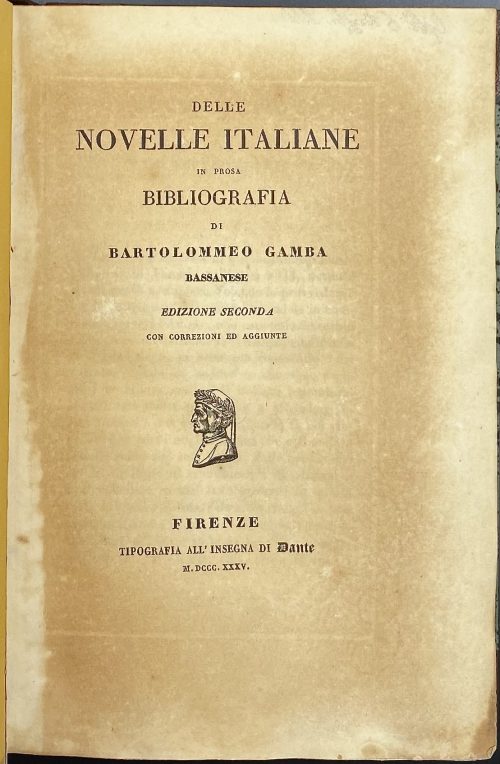 Title-page: DELLE | NOVELLE ITALIANE | IN PROSA | BIBLIOGRAFIA | DI | BARTOLOMMEO GAMBA | BASSANESE | EDIZIONE SECONDA | CON CORREZIONI ED AGGIUNTE | {publisher’s device} | FIRENZE | TIPOGRAFIA ALL’INSEGNA DI Dante | M.DCCC.XXXV. || Collation: 8vo; π8 1-198; an extra leaf between 18 and 19 (189, pp. 289-10, errata), leaf 11 unsigned, leaf 12 signed 11. Total 161 leaves plus 6 leaves of plates extraneous to collation; Plates (copperplate engravings): (1) Giovanni Boccaccio, (2) Angelo Firezuola (i.e. Agnolo Firenzuola), (3) Lorenzo Magalotti, (4) Gasparo Gozzi, and (5) Michele Colombo by Marco Comirato, and (6) Franco Sacchetti by Francesco Bosa. Pagination: [i-iii] iv-xv [xvi] [1-3] 4-290, index [16], total 322 pages plus 6 plates, unpaginated. Binding: 22.4 x 15 cm, modern brown half-morocco over green sprinkled boards, red label with gilt lettering, publisher’s yellow wrappers preserved. Edition: 2nd; the 1st edition was published in 1833. Contributors: Bartolommeo Gamba (Italian, 1766 – 1841) – author, complier. Marco Comirato (Italian, c. 1800 – 1869) – engraver. Francesco Bosa (Italian, ? – ?) – engraver. Sitters: Giovanni Boccaccio (Italian, 1313 –1375) Franco Sacchetti (Italian, c. 1335 – c. 1400) Agnolo Firenzuola] (Italian, 1493 – 1543) Lorenzo Magalotti (Italian, 1637 – 1712) Gasparo Gozzi (Italian, 1713 – 1786) Michele Colombo (Italian, 1747 – 1838)
Title-page: DELLE | NOVELLE ITALIANE | IN PROSA | BIBLIOGRAFIA | DI | BARTOLOMMEO GAMBA | BASSANESE | EDIZIONE SECONDA | CON CORREZIONI ED AGGIUNTE | {publisher’s device} | FIRENZE | TIPOGRAFIA ALL’INSEGNA DI Dante | M.DCCC.XXXV. || Collation: 8vo; π8 1-198; an extra leaf between 18 and 19 (189, pp. 289-10, errata), leaf 11 unsigned, leaf 12 signed 11. Total 161 leaves plus 6 leaves of plates extraneous to collation; Plates (copperplate engravings): (1) Giovanni Boccaccio, (2) Angelo Firezuola (i.e. Agnolo Firenzuola), (3) Lorenzo Magalotti, (4) Gasparo Gozzi, and (5) Michele Colombo by Marco Comirato, and (6) Franco Sacchetti by Francesco Bosa. Pagination: [i-iii] iv-xv [xvi] [1-3] 4-290, index [16], total 322 pages plus 6 plates, unpaginated. Binding: 22.4 x 15 cm, modern brown half-morocco over green sprinkled boards, red label with gilt lettering, publisher’s yellow wrappers preserved. Edition: 2nd; the 1st edition was published in 1833. Contributors: Bartolommeo Gamba (Italian, 1766 – 1841) – author, complier. Marco Comirato (Italian, c. 1800 – 1869) – engraver. Francesco Bosa (Italian, ? – ?) – engraver. Sitters: Giovanni Boccaccio (Italian, 1313 –1375) Franco Sacchetti (Italian, c. 1335 – c. 1400) Agnolo Firenzuola] (Italian, 1493 – 1543) Lorenzo Magalotti (Italian, 1637 – 1712) Gasparo Gozzi (Italian, 1713 – 1786) Michele Colombo (Italian, 1747 – 1838) -
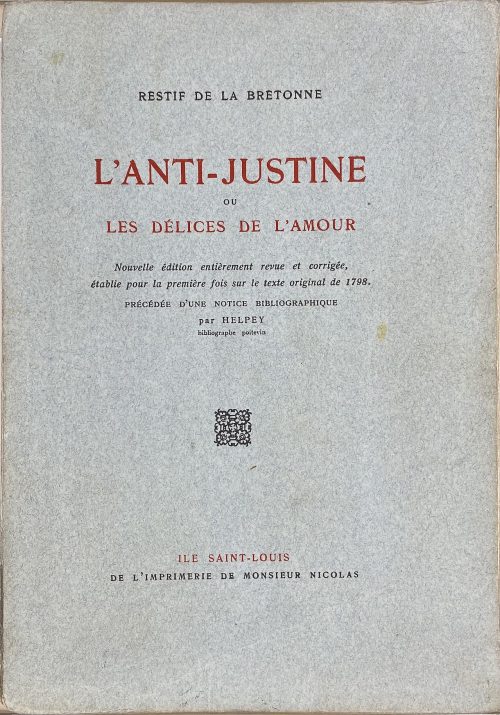 Description: One volume in grey-blue French flapped wrapper, 24 x 16.7 cm, collated 8vo, with black and red lettering to front cover, printed on watermarked thick wove paper Alfax Navarre, margins untrimmed, some pages uncut, illustrated with 12 aquatint plates signed Le Loup. Front wrapper and title (red and black): RESTIF DE LA BRETONNE | L'ANTI-JUSTINE | OU | LES DÉLICES DE L' AMOUR | Nouvelle édition entièrement revue et corrigée, | établie pour la première fois sur le texte original de 1798. | PRÉCÉDÉE D'UNE NOTICE BIBLIOGRAPHIQUE | par HELPEY | bibliographe poitevin | {device} | ILE SAINT-LOUIS | DE L’IMPRIMERIE DE Monsieur Nicolas. Limitation: Printed 350 copies, numbered 1-350, on alfax paper; this copy is № 256. Collation: 1-158 166, incl. the 1st and last leaves within the wrappers, total 126 leaves plus 12 plates extraneous to collation. Pagination: [4 blank] [1-4] 5-243 [244 blank] [4 blank], total 252 pages, ils. Catalogue raisonné: Dutel (1920-1970) № 1025, p. 45. Ref.: Danson Erotica Collection at Trinity College, Oxford – KK.6.33. Contributors: Nicolas Edmé Restif de la Bretonne (French, 1734 – 1806) – author. Louis Perceau [Helpey] (French, 1883 – 1942) – author. Maurice Henri Hector Duflou (French, 1885 – 1951) – publisher. The artist – Le Loup – unidentified.
Description: One volume in grey-blue French flapped wrapper, 24 x 16.7 cm, collated 8vo, with black and red lettering to front cover, printed on watermarked thick wove paper Alfax Navarre, margins untrimmed, some pages uncut, illustrated with 12 aquatint plates signed Le Loup. Front wrapper and title (red and black): RESTIF DE LA BRETONNE | L'ANTI-JUSTINE | OU | LES DÉLICES DE L' AMOUR | Nouvelle édition entièrement revue et corrigée, | établie pour la première fois sur le texte original de 1798. | PRÉCÉDÉE D'UNE NOTICE BIBLIOGRAPHIQUE | par HELPEY | bibliographe poitevin | {device} | ILE SAINT-LOUIS | DE L’IMPRIMERIE DE Monsieur Nicolas. Limitation: Printed 350 copies, numbered 1-350, on alfax paper; this copy is № 256. Collation: 1-158 166, incl. the 1st and last leaves within the wrappers, total 126 leaves plus 12 plates extraneous to collation. Pagination: [4 blank] [1-4] 5-243 [244 blank] [4 blank], total 252 pages, ils. Catalogue raisonné: Dutel (1920-1970) № 1025, p. 45. Ref.: Danson Erotica Collection at Trinity College, Oxford – KK.6.33. Contributors: Nicolas Edmé Restif de la Bretonne (French, 1734 – 1806) – author. Louis Perceau [Helpey] (French, 1883 – 1942) – author. Maurice Henri Hector Duflou (French, 1885 – 1951) – publisher. The artist – Le Loup – unidentified. -
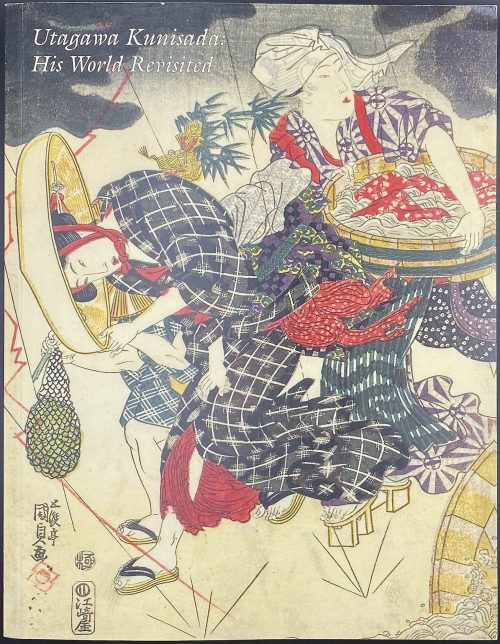 Softcover, in pictorial wrappers, 28 x 21.8 cm, 64 entries, with colour illustrations, some folding. Catalogue # 17 of the sales exhibition on March 17-21, 2021 in NY; pagination: [1-3] 4-182 [2], ils. Contributor: Sebastian Izzard Select illustrations (references in this collection):
Softcover, in pictorial wrappers, 28 x 21.8 cm, 64 entries, with colour illustrations, some folding. Catalogue # 17 of the sales exhibition on March 17-21, 2021 in NY; pagination: [1-3] 4-182 [2], ils. Contributor: Sebastian Izzard Select illustrations (references in this collection):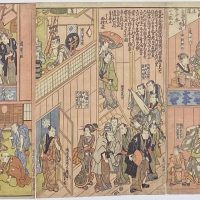
SVJP-0222.2016: A view of the dressing room of a Theater in Dōtonbori, Ōsaka.
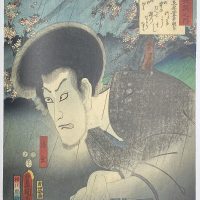
SVJP-0105.2014: Ichikawa Danjūrō VIII as the ghost of Seigen.
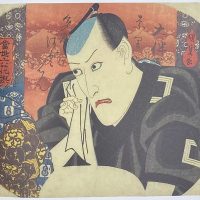
SVJP-0360.2022: Ichikawa Danjūrō VII.
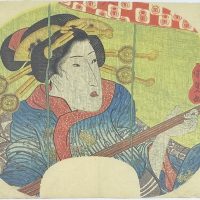
SVJP-0361.2022: Beauty playing the shamisen beneath a mosquito net.
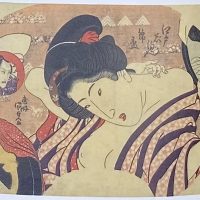
SVJP-0359.2022: Young woman checks her makeup in a mirror.
-
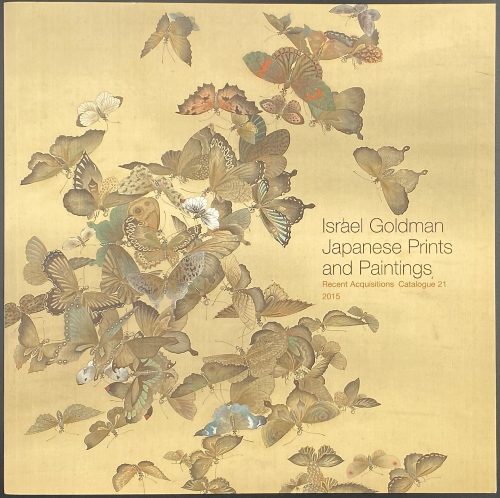 Softcover, pictorial wrappers, square 21 x 21 cm, 40 leaves, unpaginated, with illustrations in colour, 80 entries, with price list laid in; limited edition of 700 copies. Contributor: Israel Goldman In this collection:
Softcover, pictorial wrappers, square 21 x 21 cm, 40 leaves, unpaginated, with illustrations in colour, 80 entries, with price list laid in; limited edition of 700 copies. Contributor: Israel Goldman In this collection: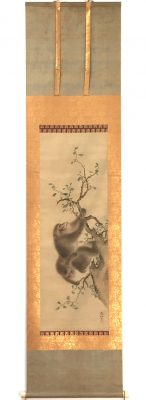
JPD-0008.2016: Mori Sosen. Ink and colour on silk.
-
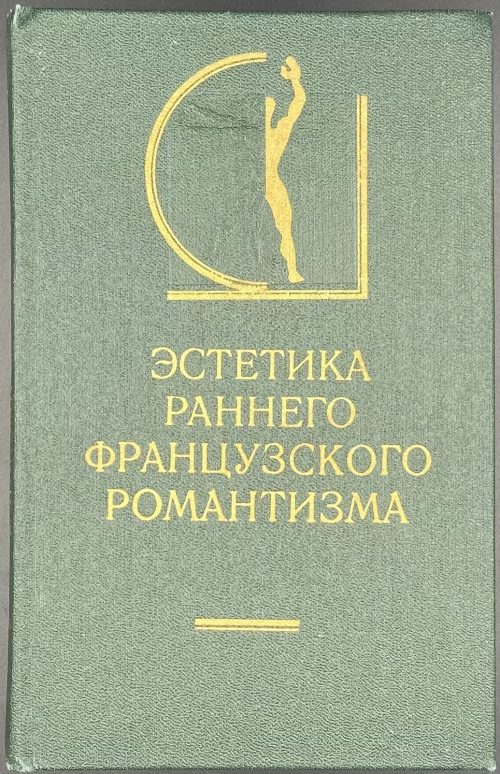 Description: Hardcover, 20.8 x 13.3 cm, green buckram with gilt lettering to spine, gilt serial design and lettering to front cover, pp.: [1-6] 7-479 [480]. Incl. Ф.-Р. де Шатобриан. «Гений христианства», пер. О. Э. Гринберг. Title-page : | — | ЭСТЕТИКА РАННЕГО ФРАНЦУЗСКОГО РОМАНТИЗМА |— | {publisher’s device} | МОСКВА | ИСКУССТВО | 1982 | 3 || François-René de Chateaubriand (French, 1768 – 1848) – author Ольга Эммануиловна Гринберг (Russian, 1950 – 2008) – translator Вера Аркадьевна Мильчина [Vera Miltchina] (Russian, b. 1953) – foreword, translator
Description: Hardcover, 20.8 x 13.3 cm, green buckram with gilt lettering to spine, gilt serial design and lettering to front cover, pp.: [1-6] 7-479 [480]. Incl. Ф.-Р. де Шатобриан. «Гений христианства», пер. О. Э. Гринберг. Title-page : | — | ЭСТЕТИКА РАННЕГО ФРАНЦУЗСКОГО РОМАНТИЗМА |— | {publisher’s device} | МОСКВА | ИСКУССТВО | 1982 | 3 || François-René de Chateaubriand (French, 1768 – 1848) – author Ольга Эммануиловна Гринберг (Russian, 1950 – 2008) – translator Вера Аркадьевна Мильчина [Vera Miltchina] (Russian, b. 1953) – foreword, translator -
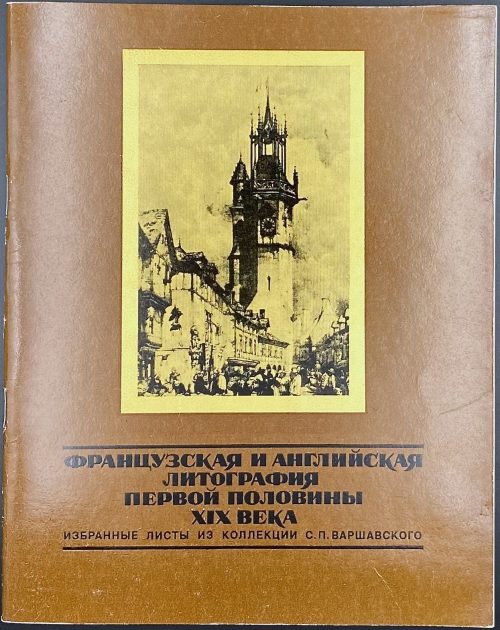 French and English lithography of the first half of the 19th century: Selected sheets from the collection of Sergei Petrovich Varshavsky [Сергей Петрович Варшавский] (Jewish-Russian, 1906 – 1980). New acquisitions at The Pushkin State Museum of Fine Arts (Moscow). Выпущено по заказу ГМИИ им. А. С. Пушкина; вступ. статьи В. А. Мишина и Ю. С. Варшавского; составитель каталога В. А. Мишин. (Produced under order of The Pushkin State Museum of Fine Arts (Moscow); introduction by V. A. Mishin and Yury Varshavsky). Softcover, glossy pictorial wrappers, 21.5 x 17 cm, 25 leaves, not paginated, frontispiece and 7 leaves of plates, 50 entries. Title-page: | — | ФРАНЦУЗСКАЯ И АНГЛИЙСКАЯ | ЛИТОГРАФИЯ | ПЕРВОЙ ПОЛОВИНЫ | XIX ВЕКА | ИЗБРАННЫЕ ЛИСТЫ ИЗ КОЛЛЕКЦИИ С.П. ВАРШАВСКОГО | — | НОВЫЕ ПОСТУПЛЕНИЯ | В ГОСУДАРСТВЕННЫЙ МУЗЕЙ | ИЗОБРАЗИТЕЛЬНЫХ | ИСКУССТВ | ИМЕНИ А. С. ПУШКИНА | {publisher’s device} | Москва | Советский художник | 1985 ||
French and English lithography of the first half of the 19th century: Selected sheets from the collection of Sergei Petrovich Varshavsky [Сергей Петрович Варшавский] (Jewish-Russian, 1906 – 1980). New acquisitions at The Pushkin State Museum of Fine Arts (Moscow). Выпущено по заказу ГМИИ им. А. С. Пушкина; вступ. статьи В. А. Мишина и Ю. С. Варшавского; составитель каталога В. А. Мишин. (Produced under order of The Pushkin State Museum of Fine Arts (Moscow); introduction by V. A. Mishin and Yury Varshavsky). Softcover, glossy pictorial wrappers, 21.5 x 17 cm, 25 leaves, not paginated, frontispiece and 7 leaves of plates, 50 entries. Title-page: | — | ФРАНЦУЗСКАЯ И АНГЛИЙСКАЯ | ЛИТОГРАФИЯ | ПЕРВОЙ ПОЛОВИНЫ | XIX ВЕКА | ИЗБРАННЫЕ ЛИСТЫ ИЗ КОЛЛЕКЦИИ С.П. ВАРШАВСКОГО | — | НОВЫЕ ПОСТУПЛЕНИЯ | В ГОСУДАРСТВЕННЫЙ МУЗЕЙ | ИЗОБРАЗИТЕЛЬНЫХ | ИСКУССТВ | ИМЕНИ А. С. ПУШКИНА | {publisher’s device} | Москва | Советский художник | 1985 || -
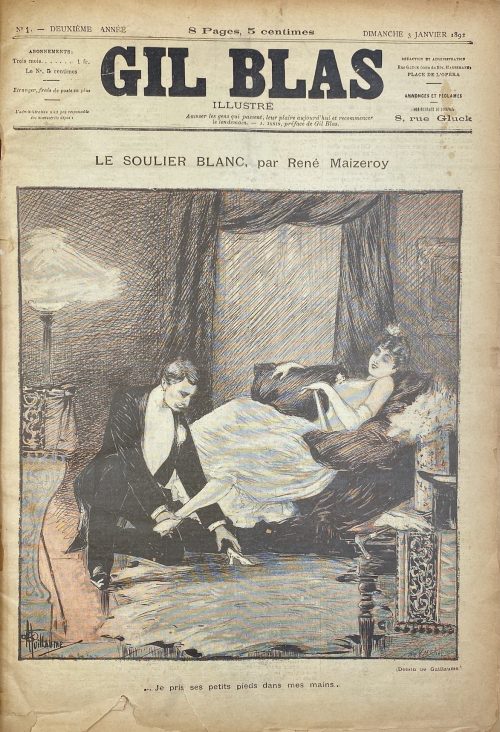 52 issues of French weekly Gil Blas illustré, 1892: №№ 1-52; published in Paris, 39 x 29 cm, bound in red half cloth over marbled boards, with gilt fillets and lettering to spine, marbled endpapers, profusely illustrated by Théophile Steinlen (Swiss-French, 1859 – 1923) and Albert Guillaume (French, 1873 – 1942).
52 issues of French weekly Gil Blas illustré, 1892: №№ 1-52; published in Paris, 39 x 29 cm, bound in red half cloth over marbled boards, with gilt fillets and lettering to spine, marbled endpapers, profusely illustrated by Théophile Steinlen (Swiss-French, 1859 – 1923) and Albert Guillaume (French, 1873 – 1942). -
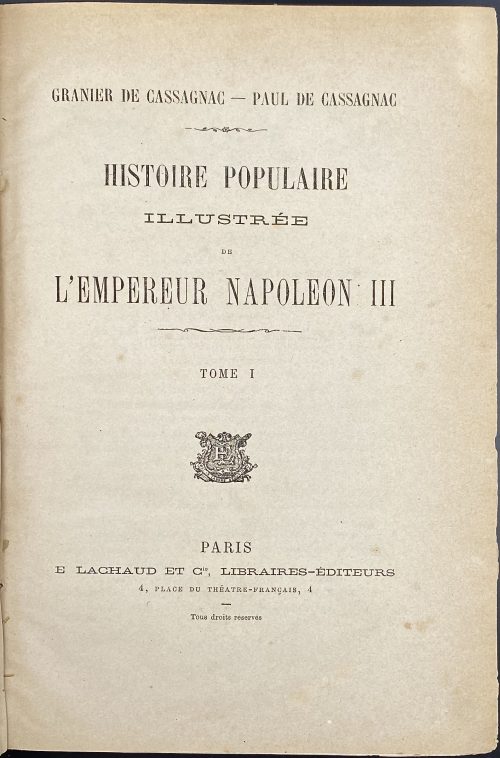 Hardcover, 28 x 20 cm, quarter sheepskin over marbled boards, marbled endpapers, gilt lettering to flat spine with gilt fillet bands, clipping pasted to front fep verso. Title-page: GRANIER DE CASSAGNAC — PAUL DE CASSAGNAC | ~ | HISTOIRE POPULAIRE | ILLUSTRÉE | DE | L'EMPEREUR NAPOLEON III | TOME I (II) | {publisher’s device} | PARIS | E. LACHAUD ET Cie, LIBRAIRES-ÉDITEURS | 4, PLACE DU THÉATRE-FRANÇAIS, 4 | – | Tous droits réservés || Collation: (v.1) π2 [1]-504, (v.2) π2 1-494; total 400 leaves plus albumen photograph pasted to frontispiece and 96 full-page woodcuts within collation. Pagination: [4] [1] 2-398 [2], [4] [1] 2-390 [2], ils.; total 800 pp. Contributors: Bernard Adolphe Granier de Cassagnac (French, 1806 – 1880) – father. Paul Adolphe Marie Prosper Granier de Cassagnac (French, 1843 – 1904) – son.
Hardcover, 28 x 20 cm, quarter sheepskin over marbled boards, marbled endpapers, gilt lettering to flat spine with gilt fillet bands, clipping pasted to front fep verso. Title-page: GRANIER DE CASSAGNAC — PAUL DE CASSAGNAC | ~ | HISTOIRE POPULAIRE | ILLUSTRÉE | DE | L'EMPEREUR NAPOLEON III | TOME I (II) | {publisher’s device} | PARIS | E. LACHAUD ET Cie, LIBRAIRES-ÉDITEURS | 4, PLACE DU THÉATRE-FRANÇAIS, 4 | – | Tous droits réservés || Collation: (v.1) π2 [1]-504, (v.2) π2 1-494; total 400 leaves plus albumen photograph pasted to frontispiece and 96 full-page woodcuts within collation. Pagination: [4] [1] 2-398 [2], [4] [1] 2-390 [2], ils.; total 800 pp. Contributors: Bernard Adolphe Granier de Cassagnac (French, 1806 – 1880) – father. Paul Adolphe Marie Prosper Granier de Cassagnac (French, 1843 – 1904) – son. -
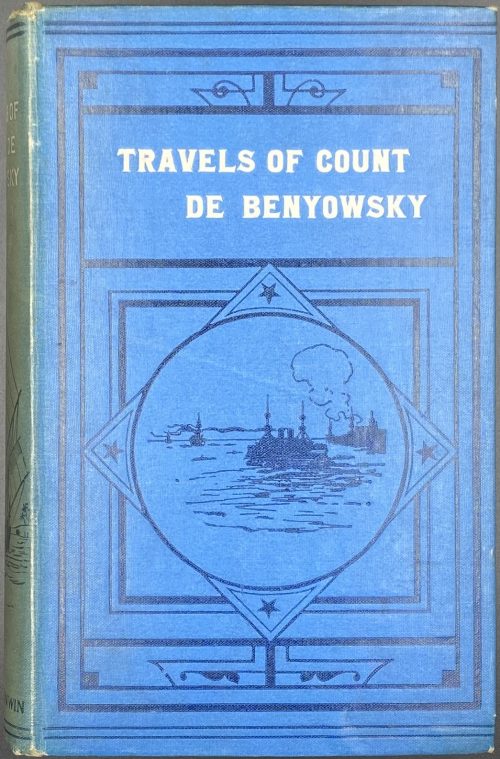 Hardcover volume in 8vo, 20.4 x 13.7 cm, blue cloth with black pictorial stamping and white embossed lettering to front cover and spine, spine sunned, head and tail frayed. Title-page: ❦❦❦ THE MEMOIRS AND | TRAVELS OF MAURITIUS | AUGUSTUS COUNT DE | BENYOWSKY ❦❦❦ | IN SIBERIA, KAMCHATKA, JAPAN, | THE LIUKIU ISLANDS AND FORMOSA | FROM THE TRANSLATION OF HIS | ORIGINAL MANUSCRIPT (1741–1771), | BY WILLIAM NICHOLSON, F.R.S., 1790 | EDITED BY CAPTAIN | PASFIELD OLIVER | ILLUSTRATED | LONDON: T. FISHER UNWIN, | PATERNOSTER SQUARE. MDCCCXCVIII || Collation/Pagination: [1]7 2-258; blue advertisement sheet laid in. [1, 2] – serial h.t. "The Adventure Series" / advert. THE ADVENTURE SERIES. Illustrated. Popular Re-issue, large cr. 8vo, 3s. 6d. 8 titles, [3, 4] – t.p. / blank, [5] 6-9 contents, [10] blank, [11, 12] missing, [13] 14-52 introduction, 53-399, [400] colophon: THE GRESHAM PRESS, | URWIN BROTHERS, | WORKING IN LONDON. Total number of leaves 199; 398 pages; one leaf of the first gathering missing (pp. 11/12 list of illustrations. No illustrations in this volume. Compared to another copy of the same edition, LIB-2701.2021, besides the binding: no list of illustrations, no illustrations, different colophon, different advertisement, slightly different h.t. Contributors: Publisher: T. Fisher Unwin (London); Thomas Fisher Unwin (British, 1848 – 1935). Author: Maurice Auguste count de Benyowsky [Мориц Август Бенёвский] (Polish-Slovak-Hungarian, 1746 –1786). Editor: Samuel Pasfield Oliver (British, 1838 – 1907). Translator: William Nicholson (British, 1753 – 1815). Originally published in 1790, in London (I have not seen it anywhere) and in Dublin by P. Wogan [etc.], and in 1791 in French, in Paris by Buisson; see LIB-2742.2021. For the 1904 edition, see LIB-2703.2021.
Hardcover volume in 8vo, 20.4 x 13.7 cm, blue cloth with black pictorial stamping and white embossed lettering to front cover and spine, spine sunned, head and tail frayed. Title-page: ❦❦❦ THE MEMOIRS AND | TRAVELS OF MAURITIUS | AUGUSTUS COUNT DE | BENYOWSKY ❦❦❦ | IN SIBERIA, KAMCHATKA, JAPAN, | THE LIUKIU ISLANDS AND FORMOSA | FROM THE TRANSLATION OF HIS | ORIGINAL MANUSCRIPT (1741–1771), | BY WILLIAM NICHOLSON, F.R.S., 1790 | EDITED BY CAPTAIN | PASFIELD OLIVER | ILLUSTRATED | LONDON: T. FISHER UNWIN, | PATERNOSTER SQUARE. MDCCCXCVIII || Collation/Pagination: [1]7 2-258; blue advertisement sheet laid in. [1, 2] – serial h.t. "The Adventure Series" / advert. THE ADVENTURE SERIES. Illustrated. Popular Re-issue, large cr. 8vo, 3s. 6d. 8 titles, [3, 4] – t.p. / blank, [5] 6-9 contents, [10] blank, [11, 12] missing, [13] 14-52 introduction, 53-399, [400] colophon: THE GRESHAM PRESS, | URWIN BROTHERS, | WORKING IN LONDON. Total number of leaves 199; 398 pages; one leaf of the first gathering missing (pp. 11/12 list of illustrations. No illustrations in this volume. Compared to another copy of the same edition, LIB-2701.2021, besides the binding: no list of illustrations, no illustrations, different colophon, different advertisement, slightly different h.t. Contributors: Publisher: T. Fisher Unwin (London); Thomas Fisher Unwin (British, 1848 – 1935). Author: Maurice Auguste count de Benyowsky [Мориц Август Бенёвский] (Polish-Slovak-Hungarian, 1746 –1786). Editor: Samuel Pasfield Oliver (British, 1838 – 1907). Translator: William Nicholson (British, 1753 – 1815). Originally published in 1790, in London (I have not seen it anywhere) and in Dublin by P. Wogan [etc.], and in 1791 in French, in Paris by Buisson; see LIB-2742.2021. For the 1904 edition, see LIB-2703.2021. -
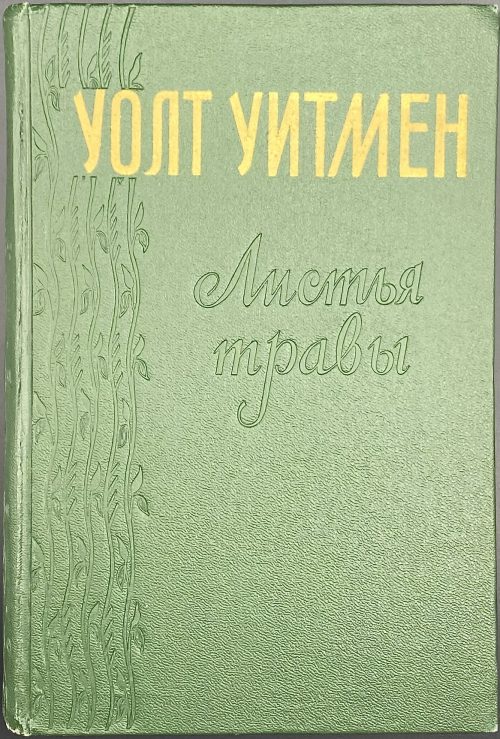 Hardcover volume, 22.8 x 15.5 cm, bound in green buckram with blind stamped designs and gilt lettering to front cover and spine, blind lettering to back, pp.: [2] 3-354 [2], photo portrait frontispiece; collated in 8vo: 1-218 2210, 178 leaves (356 pp.) Title-page (green and black): УОЛТ УИТМЕН | ЛИСТЬЯ ТРАВЫ | {vignette} | ГОСУДАРСТВЕННОЕ ИЗДАТЕЛЬСТВО | ХУДОЖЕСТВЕННОЙ ЛИТЕРАТУРЫ | МОСКВА 1955 || Original: Walt Whitman. Leaves of Grass see LIB-3111.2022. Contributors: Walter [Walt] Whitman (American, 1819 – 1892) – author/poetry. Korney Chukovsky [Корней Иванович Чуковский, Николай Корнейчуков] (Russian, 1882 – 1969) – translator, author/foreword. Морис Осипович Мендельсон (Jewish-Russian, 1904 – 1982) – author/foreword. Translators: Николай Васильевич Банников (Russian, 1918 – 1996) Михаил Александрович Зенкевич (Russian, 1886 – 1973) Иван Александрович Кашкин (Russian, 1899 – 1963) Анатолий Васильевич Старостин (Russian, 1919 – 1980) Дмитрий Александрович Горбов (Russian, 1894 – 1967) Мария Фёдоровна Лорие (Russian, 1904 – 1992) Вильгельм Вениаминович Левик (Jewish-Russian, 1906 – 1982)
Hardcover volume, 22.8 x 15.5 cm, bound in green buckram with blind stamped designs and gilt lettering to front cover and spine, blind lettering to back, pp.: [2] 3-354 [2], photo portrait frontispiece; collated in 8vo: 1-218 2210, 178 leaves (356 pp.) Title-page (green and black): УОЛТ УИТМЕН | ЛИСТЬЯ ТРАВЫ | {vignette} | ГОСУДАРСТВЕННОЕ ИЗДАТЕЛЬСТВО | ХУДОЖЕСТВЕННОЙ ЛИТЕРАТУРЫ | МОСКВА 1955 || Original: Walt Whitman. Leaves of Grass see LIB-3111.2022. Contributors: Walter [Walt] Whitman (American, 1819 – 1892) – author/poetry. Korney Chukovsky [Корней Иванович Чуковский, Николай Корнейчуков] (Russian, 1882 – 1969) – translator, author/foreword. Морис Осипович Мендельсон (Jewish-Russian, 1904 – 1982) – author/foreword. Translators: Николай Васильевич Банников (Russian, 1918 – 1996) Михаил Александрович Зенкевич (Russian, 1886 – 1973) Иван Александрович Кашкин (Russian, 1899 – 1963) Анатолий Васильевич Старостин (Russian, 1919 – 1980) Дмитрий Александрович Горбов (Russian, 1894 – 1967) Мария Фёдоровна Лорие (Russian, 1904 – 1992) Вильгельм Вениаминович Левик (Jewish-Russian, 1906 – 1982) -
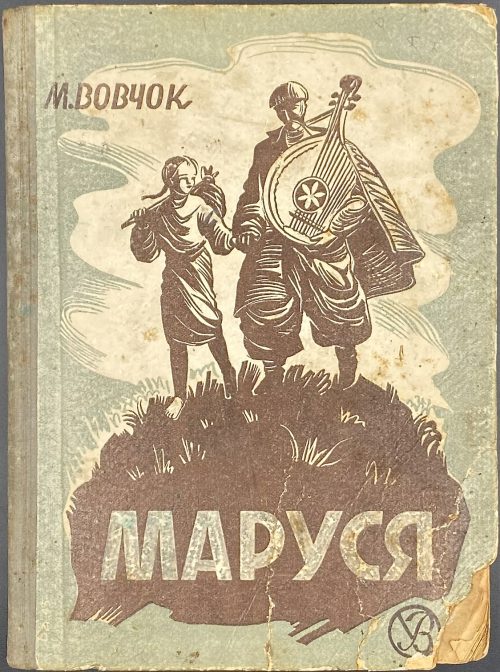 Hardcover, 20.5 x 15.2 cm, pictorial paper over cardboard, cloth-backed; pp.: [1-2] 3-98 [2], last page blank; collated 8vo: 1-58 610; 50 leaves total. Title-page: МАРКО ВОВЧОК | МАРУСЯ | ПОВIСТЬ | УКРАЇНСЬКЕ ВИДАВНИЦТВО | — | КРАКІВ 1943 ЛЬВІВ || Contributors: Марко Вовчок [Marko Vovchok; Марія Олександрівна Вілінська] (Ukrainian, 1833 – 1907) – author. «Українське видавництво» у Кракові-Львові [Verlag: „Ukrainischer Verlag“]– publisher. З друкарні „Поспішної“, Краків, Райхсштрассе 34 [Buchdruck. „Pospieschna“, Krakau, Reichsstrasse 34] – printer. Reichsstrasse (Krakow, Poland) = Ulica Karmelicka (Kraków, Poland). The French version of the Ukrainian name Маруся —> MAROUSSIA. The French version of the book: LIB-2674.2021. Other variants of the author's name Марко Вовчок: Markowovzok and Marko Vovtchok.
Hardcover, 20.5 x 15.2 cm, pictorial paper over cardboard, cloth-backed; pp.: [1-2] 3-98 [2], last page blank; collated 8vo: 1-58 610; 50 leaves total. Title-page: МАРКО ВОВЧОК | МАРУСЯ | ПОВIСТЬ | УКРАЇНСЬКЕ ВИДАВНИЦТВО | — | КРАКІВ 1943 ЛЬВІВ || Contributors: Марко Вовчок [Marko Vovchok; Марія Олександрівна Вілінська] (Ukrainian, 1833 – 1907) – author. «Українське видавництво» у Кракові-Львові [Verlag: „Ukrainischer Verlag“]– publisher. З друкарні „Поспішної“, Краків, Райхсштрассе 34 [Buchdruck. „Pospieschna“, Krakau, Reichsstrasse 34] – printer. Reichsstrasse (Krakow, Poland) = Ulica Karmelicka (Kraków, Poland). The French version of the Ukrainian name Маруся —> MAROUSSIA. The French version of the book: LIB-2674.2021. Other variants of the author's name Марко Вовчок: Markowovzok and Marko Vovtchok. -
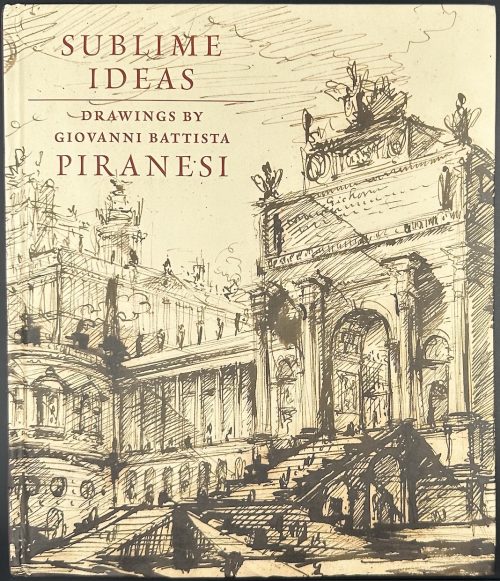 Hardcover volume, 28.7 x 24.7 cm, pictorial paper boards, pictorial endpapers, pp. :[1-6] 7-224, 207 colour ils. Published on the occasion of an exhibition at the Morgan Library & Museum, 10 March to 4 June 2023. Title-page: SUBLIME IDEAS | — | DRAWINGS BY | GIOVANNI BATTISTA | PIRANESI | John Marciari | THE MORGAN LIBRARY & MUSEUM, NEW YORK | in association with | PAUL HOLBERTON PUBLISHING || Contributors: John Marciari (American, b. 1971) – author. Giovanni Battista [Giambattista] Piranesi (Italian, 1720 – 1778) – artist.
Hardcover volume, 28.7 x 24.7 cm, pictorial paper boards, pictorial endpapers, pp. :[1-6] 7-224, 207 colour ils. Published on the occasion of an exhibition at the Morgan Library & Museum, 10 March to 4 June 2023. Title-page: SUBLIME IDEAS | — | DRAWINGS BY | GIOVANNI BATTISTA | PIRANESI | John Marciari | THE MORGAN LIBRARY & MUSEUM, NEW YORK | in association with | PAUL HOLBERTON PUBLISHING || Contributors: John Marciari (American, b. 1971) – author. Giovanni Battista [Giambattista] Piranesi (Italian, 1720 – 1778) – artist. -
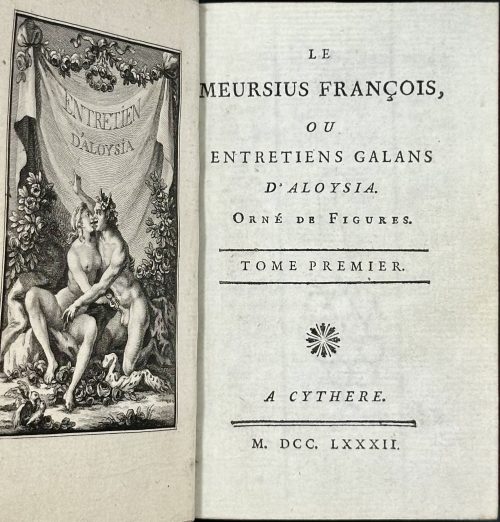 Hardcover volume, 12mo, 125 x 85 mm, two parts in one, bound and gilded by Cuzin and Maillard, respectively, between 1876 and 1881, in crimson crushed morocco with raised bands and gilt lettering to spine, marbled endpapers, all edges gilt, gilt dentelle, signed 'Cuzin' to foot of front turn-in and 'Maillard dor.' to rear. Adorned with engraved frontispiece and 12 plates by Elluin after Borel. Text printed on a slightly bluish paper. Title-page: LE | MEURSIUS FRANÇOIS, | OU | ENTRETIENS GALANS | D'ALOYSIA. | ORNÉ | DE FIGURES. | — | TOME PREMIER (SECOND) | — | ✵ | A CYTHERE | — | M. DCC. LXXXII. || Collation: 12mo, π4 (2 blanks) A-Z6 χ1,+ π2 A-S6 (4 blanks) χ1, total 254 leaves; pagination: [8] [1] 2-277 [278 blank], [4] [1] 2-210 [8 blanks], total 508 pages, plus 13 engraved plates, incl. frontispiece. Catalogue raisonné: Cohen-de Ricci 240; Eros invaincu 17; Fekete 51; Nordmann (I) 91. Contributors: Nicolas Chorier (French, 1612 – 1692) – author. Antoine Borel (French, 1743 – 1810) – artist. François-Rolland Elluin (French, 1745 – c. 1822) – engraver. Hubert-Martin Cazin (French, 1724 – 1795) – publisher. Francisque Cuzin (French, 1836 – 1890) – bookbinder. Seller’s description: Erotica.- [Chorier (Nicolas)]Le Meursius François, ou Entretiens galans d'Aloysia, 2 parts in 1, half-title to each part, engraved frontispiece and 12 plates [by Elluin after Borel], handsomely bound in crimson crushed morocco by Cuzin, spine with gilt lettering and five raised bands, gilt tooled turn-ins by Maillard, signed 'Cuzin' to foot of front turn-in and 'Maillard dor.' to rear, marbled endpapers, g.e., fractional rubbing to extremities, an excellent copy, 12mo, Cythere [but Paris], [Cazin], 1782.
Hardcover volume, 12mo, 125 x 85 mm, two parts in one, bound and gilded by Cuzin and Maillard, respectively, between 1876 and 1881, in crimson crushed morocco with raised bands and gilt lettering to spine, marbled endpapers, all edges gilt, gilt dentelle, signed 'Cuzin' to foot of front turn-in and 'Maillard dor.' to rear. Adorned with engraved frontispiece and 12 plates by Elluin after Borel. Text printed on a slightly bluish paper. Title-page: LE | MEURSIUS FRANÇOIS, | OU | ENTRETIENS GALANS | D'ALOYSIA. | ORNÉ | DE FIGURES. | — | TOME PREMIER (SECOND) | — | ✵ | A CYTHERE | — | M. DCC. LXXXII. || Collation: 12mo, π4 (2 blanks) A-Z6 χ1,+ π2 A-S6 (4 blanks) χ1, total 254 leaves; pagination: [8] [1] 2-277 [278 blank], [4] [1] 2-210 [8 blanks], total 508 pages, plus 13 engraved plates, incl. frontispiece. Catalogue raisonné: Cohen-de Ricci 240; Eros invaincu 17; Fekete 51; Nordmann (I) 91. Contributors: Nicolas Chorier (French, 1612 – 1692) – author. Antoine Borel (French, 1743 – 1810) – artist. François-Rolland Elluin (French, 1745 – c. 1822) – engraver. Hubert-Martin Cazin (French, 1724 – 1795) – publisher. Francisque Cuzin (French, 1836 – 1890) – bookbinder. Seller’s description: Erotica.- [Chorier (Nicolas)]Le Meursius François, ou Entretiens galans d'Aloysia, 2 parts in 1, half-title to each part, engraved frontispiece and 12 plates [by Elluin after Borel], handsomely bound in crimson crushed morocco by Cuzin, spine with gilt lettering and five raised bands, gilt tooled turn-ins by Maillard, signed 'Cuzin' to foot of front turn-in and 'Maillard dor.' to rear, marbled endpapers, g.e., fractional rubbing to extremities, an excellent copy, 12mo, Cythere [but Paris], [Cazin], 1782. -
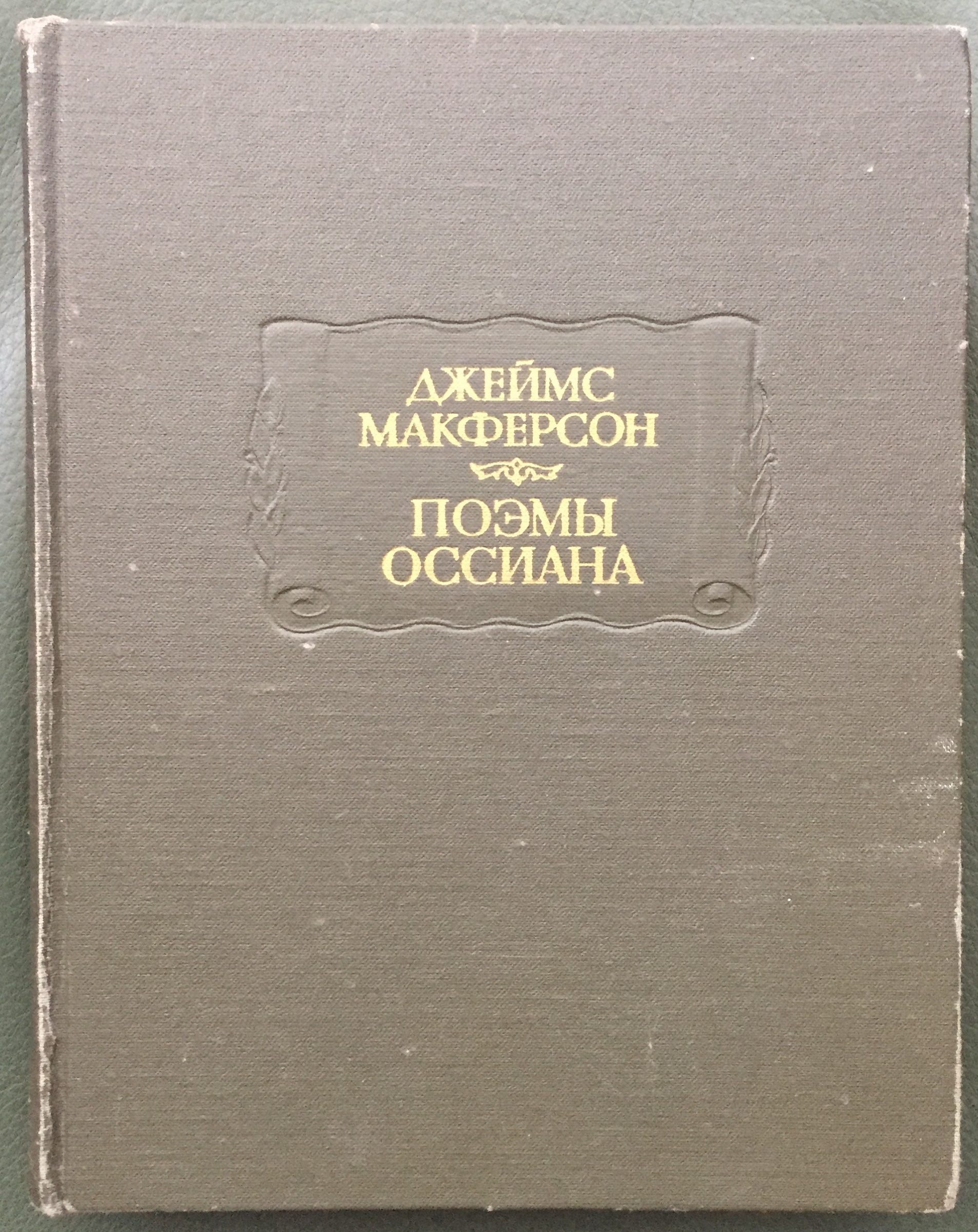 Title (black and red): ДЖЕЙМС МАКФЕРСОН | ПОЭМЫ ОССИАНА | {device} | ИЗДАНИЕ ПОДГОТОВИЛ | Ю. Д. ЛЕВИН | ИЗДАТЕЛЬСТВО «НАУКА» | ЛЕНИНГРАДСКОЕ ОТДЕЛЕНИЕ | ЛЕНИНГРАД | 1983 || Title verso: РЕДАКЦИОННАЯ КОЛЛЕГИЯ СЕРИИ | «ЛИТЕРАТУРНЫЕ ПАМЯТНИКИ» | (list of names) | Ответственный редактор | академик М. П. АЛЕКСЕЕВ (in frame) | Редактор перевода | Э. Л. ЛИНЕЦКАЯ. Frontispiece (black and red): JAMES MACPHERSON | THE POEMS OF OSSIAN | {device} || Print run: 30,000 copies. Collation: 8vo; [1]8 2-378. Pagination: [1, 2] – serial h.t. / frontis.] [3, 4] – t.p. / editorial board] [portrait / blank] [5, 6] – original t.p. fac-simile / text, 7–589 [590] – imprint, [2] – advert.; 3 leaves of plates. Binding: serial green buckram blind-stamped with a scroll adorned with gold lettering to board and spine. Джеймс Макферсон. Поэмы Оссиана. Ю. Д. Левин. Э. Л. Линецкая.
Title (black and red): ДЖЕЙМС МАКФЕРСОН | ПОЭМЫ ОССИАНА | {device} | ИЗДАНИЕ ПОДГОТОВИЛ | Ю. Д. ЛЕВИН | ИЗДАТЕЛЬСТВО «НАУКА» | ЛЕНИНГРАДСКОЕ ОТДЕЛЕНИЕ | ЛЕНИНГРАД | 1983 || Title verso: РЕДАКЦИОННАЯ КОЛЛЕГИЯ СЕРИИ | «ЛИТЕРАТУРНЫЕ ПАМЯТНИКИ» | (list of names) | Ответственный редактор | академик М. П. АЛЕКСЕЕВ (in frame) | Редактор перевода | Э. Л. ЛИНЕЦКАЯ. Frontispiece (black and red): JAMES MACPHERSON | THE POEMS OF OSSIAN | {device} || Print run: 30,000 copies. Collation: 8vo; [1]8 2-378. Pagination: [1, 2] – serial h.t. / frontis.] [3, 4] – t.p. / editorial board] [portrait / blank] [5, 6] – original t.p. fac-simile / text, 7–589 [590] – imprint, [2] – advert.; 3 leaves of plates. Binding: serial green buckram blind-stamped with a scroll adorned with gold lettering to board and spine. Джеймс Макферсон. Поэмы Оссиана. Ю. Д. Левин. Э. Л. Линецкая. -
 Magazine article by Edgar Jepson: The Iron Tsuba of Japan (Section: Oriental Art), published in volume Vol. 70 (September–December) of The Connoisseur: An Illustrated Magazine for Collectors, Vol. 70 (September–December); pp. 143-152 / C. Reginald Grundy [ed.] — London: Published by the Proprietor, W. CLAUSE JOHNSON, at the Editorial and Advertisement Offices of The Connoisseur, 1924. Owner's half black morocco, gilt lettering to spine, blue cloth boards. Two volumes bound together without original covers. Size 28.5 x 22 cm. Vol. 1: The Connoisseur | An Illustrated Magazine | For Collectors | Edited by C. Reginald Grundy | Vol. LXIX. | (MAY—AUGUST, 1924) | LONDON | Published by the Proprietor, W. CLAUSE JOHNSON, at the | Editorial and Advertisement Offices of The Connoisseur, | at 1, Duke Street, St. James's, S.W. 1 | 1924 || Pp.: [i-ii] iii-xviii [xix] [1, 2 - plate] 3-249 [250]. Vol. 2: The Connoisseur | An Illustrated Magazine | For Collectors | Edited by C. Reginald Grundy | Vol. LXX. | (SEPTEMBER—DECEMBER, 1924) | LONDON | Published by the Proprietor, W. CLAUSE JOHNSON, at the | Editorial and Advertisement Offices of The Connoisseur, | at 1, Duke Street, St. James's, S.W. 1 | 1924 || Pp.: [i-ii] iii-xxii [2 blanks] [1, 2 - plate] 3-261 [262]. The Iron Tsuba of Japan by Edgar Jepson The heart of Japan was in the sword. However admirable may be the paintings, the prints, the netsuke, the lacquer, or the bronzes of the Japanese masters, the supreme artistic achievements of Japan were the blades of Masamune, Muramasa, Sadamune, and Rai Kunitsugu. But not a little of the heart of Japan went also in the tsuba, the guard which protected the hand that wielded the blade, into the iron tsuba of the fighting Samurai. Beside the forgers of the iron tsuba of Japan the ironsmiths of the rest of the world have been mere children. The earliest tsuba were of bronze or copper, often gilded. It is probable that they were replaced by iron tsuba during the Kamakura period, the great fighting era, which lasted from A.D. 1185 to 1333. During the later half of the twelfth century leather tsuba, strengthened by thin iron plates or a metal rim, also replaced the bronze and copper tsuba. It was at this time that a family of armourers of the name of Masuda, and in particular Masuda Munesuke, the founder of the Myochin family, began to forge iron tsuba — thin, round plates of great hardness and density. But it is probable that no tsuba perforated with a view to decorative effects were forged before the end of the fourteenth century. These fourteenth-century tsuba are exceedingly rare in England. I have seen none in the museums, none in the famous collections that have been sold during the last ten years. Those photographed in Herr Oeder's book might easily be the fifteenth century. No. 1 is a curious cup-shape tsuba decorated with a bronze and copper inlay. No. 2, with its edges curiously twisted in the forging, looks like Myochin work. But it is not of the Myochin iron. The Myochin family produced some of the greatest ironsmiths of Japan. Armourers first of all, tsubasmiths, forgers of sake-kettles, articulated reptiles, crustacea, and insects — everything that can be done with iron they did; they pushed their medium to its limit. They were forging iron tsuba in 1160, and they were still forging them in 1860. And it was their own iron, or rather their own steel. They discovered the secret of it early, and they kept that secret in the family for all those hundreds of years. There is no mistaking a Myochin tsuba: balance it on your finger and tap it with a piece of metal, always it gives forth a clear bell-like ring that you get from the work of no other ironsmith, Japanese or European. Always the Myochin tsuba is before everything a protection to the hand of the swordsman; to that everything is, as it should be, subordinated. No. 3 is a Myochin tsuba of the fifteenth century, and probably of the early fifteenth century. No. 4, by Myochin Munetaka, perforated with a grotesque figure, is an example of that twisting and twisting of the iron in the forging till it forms a pattern like the grain of wood. The Myochin smiths invented these wood-grain tsuba, and no other smiths equalled them in their forging. In the sixteenth century, the fighting tsuba was probably at its best. It was a century of great tsubasmiths. Then the first Nobuiye, whose tsuba fetched £100 apiece, circa 1800, in Japan, and the first Kaneiye flourished. No. 5 is a tsuba forged by a great smith, Iyesada of Sotome, in the manner of Nobuiye I, decorated with the karakusa tendrils that Nobuiye delighted in, with lightning and clouds. No. 6 is a guard of Sanada Tembo, the chief smith of the Tembo family, stamped, punning fashion, with the character Tembo. Akin to the Tembo tsuba were those of the Kiami and Hoan smiths. Then also the Heianjo smiths and the Owari smiths, especially those of Nagoya and the Yamakichi family, forged their strongest tsuba. Those of the Yamakichi were tested after the forging by being pounded in iron mortars — at least, so the legend runs. But they were a sternly utilitarian family, and I have never seen a Yamakichi tsuba of any beauty. In the later half of the fifteenth century arose the fashion of decorating tsuba with an inlay, zogan, of bronze. The Heianjo tsuba, forged at Kyoto in the latter half of the fifteenth and the beginning of the sixteenth century, were often thus inlaid. The earliest of them were called "Onin", of which No. 7 is an example. In addition to the bronze inlay around the edge, it is inlaid with a representation, some say, of snow; others say, of the duckweed on a pond. No. 8 is probably a Heianjo tsuba, but I am not quite sure about it. The inlaid acacia branches might be very early Shoami work. But to judge by the iron, it is a fifteenth-century tsuba; and the authorities place the beginning of the Shoami school not later than early in the sixteenth century. No. 10 is an example of the Fushimi-zogan, a flat inlay of a light-coloured bronze. These tsuba took their name from the fact that they were first forged at Fushimi, in Yamashiro, in the sixteenth century. It is of the type known as Mon-zukashi, perforated with crests (mon) à jour. The Yoshiro-zogan tsuba were also first forged at Fushimi by Yoshiro Naomasa. They were distinguished from the Fushimi-zogan by the fact that their inlay was generally a little raised-not always-for the inlay of No. 9, a tsuba forged by a later nineteenth-century Yoshiro, is quite flat. It is an interesting tsuba, for, with its decoration grown florid and excessive, it marks the intermediate stage between the simple and delightful designs of the genuine fighting tsuba and the elaborate pictures in gold and silver on the tsuba of the eighteenth-century smiths of Awa and Kyoto, which have become mere ornaments of the goldsmith. The Gomoku-zogan (No. 11) tsuba were probably first forged earlier than the Fushimi and Yoshiro-zogan tsuba. This inlay, in slight relief, is a representation in a light-coloured bronze and copper of twigs caught in the eddies of streams. The seventeenth century and early eighteenth century were the great periods of perforated tsuba. The designs, and they are often admirable, are for the most part in plain fretwork; but they are also chased. No. 12, a crane under an acacia, is a tsuba of a Higo smith, great forgers of fighting tsuba during this period. These smiths also excelled in nunome zogan, a very thin gold and silver inlay, with which they further decorated their perforated guards. The smiths of the Umetada and Shoami families also forged iron tsuba during this period; but their designs, though sometimes pleasing enough, are rarely fine. The best work of Myoju Umetada is in sentoku, not iron. The Choshu smiths, coming later, surpass the perforated guards of both the Umetada and Shoami smiths in beauty of design. No. 13, a lotus in the round, not only fretwork, but also engraved, is a good example of the admirable balance they so often attained in their designs. It is a sufficiently realistic lotus, but yet of a delightful simplicity. In considerable contrast is No. 14, the dragon by Soheishi Soten — one of the only two authentic tsuba of his forging known — the first forger of hikone-bori tsuba, which were in extraordinary favour in Japan during the eighteenth century, and illustrated every important event in Japanese history. It is on the elaborate side, but fine, strong work, and an excellent guard to the hand, for the lighter and more open part, which gives the design its admirable balance, is on the inside, and not exposed to the full swing of an opponent's blade. A few years ago there was a tendency to decry the Namban tsuba as having sprung too directly from foreign sources. But though the original suggestion may have been Chinese, or, as some say, Portuguese, the Japanese made it entirely their own, as characteristically Japanese as anything can well be, but, it must be admitted, of a decadent period. The school took its rise at the beginning of the seventeenth century, and the early tsuba were forged of a specially hard iron, the Wootz, imported from Southern India. No. 15, the signs of the Zodiac, is an excellent tsuba from the fighting point of view. Both it and No. 16 are of quite charming, if elaborate, design, and both of them, with their delicate scroll-work, so astonishingly undercut, are the very last word in the work of the ironsmith-veritable iron lace. To return to the simpler perforated tsuba, the smiths of Akasaka, a suburb of Tokyo, produced probably the most charming designs. Their style derives considerably from the Higo smiths, and their earlier fighting tsuba are very like the Higo tsuba. But always their work was just a little lighter than that of the Higo smiths, and in the end they moved right away from them and became the forgers of very light guards indeed. No. 17, is a representation of the Hiyokudori, the fabulous double bird, in which were reincarnated the souls of the two lovers, Gompachi and Komurasaki; and No. 18, “the tsuba of a hundred ducks "— there are about forty — are characteristic designs of the school. In the work of the Akasaka smiths the balance, which makes the design of a good tsuba so admirable and delightful, attains its height. This admirable balance seems often to be obtained by a deliberate sacrifice of symmetry. About nine hundred and ninety-nine European ironsmiths out of a thousand would have made the right and left sides of the Hiyoku-dori line by line, and perforation by perforation, exactly alike; he would have cut out exactly as many ducks on the one side of “the tsuba of a hundred ducks” as on the other, and made each duck on the right side correspond exactly in position and attitude with a duck on the left side. By variations the tsubasmith attained a finer balance, almost a higher symmetry. No. 19, often called by collectors the "rose-window" tsuba, but really a stylised chrysanthemum, is a favourite design of the Akasaka smiths, but Hizen work and inlaid in the Hizen manner with gold nunome. No. 20 is a Satsuma tsuba of the middle period. The Satsuma smiths of the nineteenth century produced probably the most ornate of all the iron guards, for the most part calibashes and beans with their leaves and tendrils realistic in the extreme, but of charming design. Few crafts have been carried further than that of the tsubasmith; few crafts working in a difficult medium have handled more subjects with greater feeling for beauty or greater liveliness of fancy. It is interesting to note again and again how school influences school, and smith influences smith. But, as in all the applied arts, the finest tsuba were forged by men who never lost sight of the purpose of a tsuba, that it is before everything a protection to the hand, and never subjected that purpose to a passion for virtuosity. Illustrations: No 1. FOURTEENTH-CENTURY TSUBA, WITH BRONZE AND COPPER INLAY No. 2. FOURTEENTH-CENTURY TSUBA, RESEMBLING MYOCHIN WORK No. 3. MYOCHIN TSUBA, FIFTEENTH CENTURY No. 4. MYOCHIN TSUBA, NINETEENTH CENTURY No. 5. SIXTEENTH-CENTURY TSUBA No. 6. SIXTEENTH-CENTURY TSUBA BY IYESADA OF SOTOME BY SANADA TEMBO No. 7. ONIN TSUBA No. 8. HEIANJO (?) TSUBA No. 9. YOSHIRO TSUBA, NINETEENTH CENTURY No. 10. FUSHIMI-ZOGAN, NINETEENTH CENTURY No. 11.- GOMOKU-ZOGAN, SIXTEENTH CENTURY No. 12. HIGO TSUBA, SEVENTEENTH CENTURY No. 13. CHOSHU TSUBA, SEVENTEENTH CENTURY No. 14. SOTEN TSUBA, SEVENTEENTH CENTURY No. 15. NAMBAN TSUBA, EIGHTEENTH CENTURY No. 16. NAMBAN TSUBA, NINETEENTH CENTURY Nos. 17. AND 18. AKASAKA TSUBA, EIGHTEENTH CENTURY No. 19. HIZEN TSUBA, EIGHTEENTH CENTURY No. 20. SATSUMA TSUBA, EIGHTEENTH CENTURY
Magazine article by Edgar Jepson: The Iron Tsuba of Japan (Section: Oriental Art), published in volume Vol. 70 (September–December) of The Connoisseur: An Illustrated Magazine for Collectors, Vol. 70 (September–December); pp. 143-152 / C. Reginald Grundy [ed.] — London: Published by the Proprietor, W. CLAUSE JOHNSON, at the Editorial and Advertisement Offices of The Connoisseur, 1924. Owner's half black morocco, gilt lettering to spine, blue cloth boards. Two volumes bound together without original covers. Size 28.5 x 22 cm. Vol. 1: The Connoisseur | An Illustrated Magazine | For Collectors | Edited by C. Reginald Grundy | Vol. LXIX. | (MAY—AUGUST, 1924) | LONDON | Published by the Proprietor, W. CLAUSE JOHNSON, at the | Editorial and Advertisement Offices of The Connoisseur, | at 1, Duke Street, St. James's, S.W. 1 | 1924 || Pp.: [i-ii] iii-xviii [xix] [1, 2 - plate] 3-249 [250]. Vol. 2: The Connoisseur | An Illustrated Magazine | For Collectors | Edited by C. Reginald Grundy | Vol. LXX. | (SEPTEMBER—DECEMBER, 1924) | LONDON | Published by the Proprietor, W. CLAUSE JOHNSON, at the | Editorial and Advertisement Offices of The Connoisseur, | at 1, Duke Street, St. James's, S.W. 1 | 1924 || Pp.: [i-ii] iii-xxii [2 blanks] [1, 2 - plate] 3-261 [262]. The Iron Tsuba of Japan by Edgar Jepson The heart of Japan was in the sword. However admirable may be the paintings, the prints, the netsuke, the lacquer, or the bronzes of the Japanese masters, the supreme artistic achievements of Japan were the blades of Masamune, Muramasa, Sadamune, and Rai Kunitsugu. But not a little of the heart of Japan went also in the tsuba, the guard which protected the hand that wielded the blade, into the iron tsuba of the fighting Samurai. Beside the forgers of the iron tsuba of Japan the ironsmiths of the rest of the world have been mere children. The earliest tsuba were of bronze or copper, often gilded. It is probable that they were replaced by iron tsuba during the Kamakura period, the great fighting era, which lasted from A.D. 1185 to 1333. During the later half of the twelfth century leather tsuba, strengthened by thin iron plates or a metal rim, also replaced the bronze and copper tsuba. It was at this time that a family of armourers of the name of Masuda, and in particular Masuda Munesuke, the founder of the Myochin family, began to forge iron tsuba — thin, round plates of great hardness and density. But it is probable that no tsuba perforated with a view to decorative effects were forged before the end of the fourteenth century. These fourteenth-century tsuba are exceedingly rare in England. I have seen none in the museums, none in the famous collections that have been sold during the last ten years. Those photographed in Herr Oeder's book might easily be the fifteenth century. No. 1 is a curious cup-shape tsuba decorated with a bronze and copper inlay. No. 2, with its edges curiously twisted in the forging, looks like Myochin work. But it is not of the Myochin iron. The Myochin family produced some of the greatest ironsmiths of Japan. Armourers first of all, tsubasmiths, forgers of sake-kettles, articulated reptiles, crustacea, and insects — everything that can be done with iron they did; they pushed their medium to its limit. They were forging iron tsuba in 1160, and they were still forging them in 1860. And it was their own iron, or rather their own steel. They discovered the secret of it early, and they kept that secret in the family for all those hundreds of years. There is no mistaking a Myochin tsuba: balance it on your finger and tap it with a piece of metal, always it gives forth a clear bell-like ring that you get from the work of no other ironsmith, Japanese or European. Always the Myochin tsuba is before everything a protection to the hand of the swordsman; to that everything is, as it should be, subordinated. No. 3 is a Myochin tsuba of the fifteenth century, and probably of the early fifteenth century. No. 4, by Myochin Munetaka, perforated with a grotesque figure, is an example of that twisting and twisting of the iron in the forging till it forms a pattern like the grain of wood. The Myochin smiths invented these wood-grain tsuba, and no other smiths equalled them in their forging. In the sixteenth century, the fighting tsuba was probably at its best. It was a century of great tsubasmiths. Then the first Nobuiye, whose tsuba fetched £100 apiece, circa 1800, in Japan, and the first Kaneiye flourished. No. 5 is a tsuba forged by a great smith, Iyesada of Sotome, in the manner of Nobuiye I, decorated with the karakusa tendrils that Nobuiye delighted in, with lightning and clouds. No. 6 is a guard of Sanada Tembo, the chief smith of the Tembo family, stamped, punning fashion, with the character Tembo. Akin to the Tembo tsuba were those of the Kiami and Hoan smiths. Then also the Heianjo smiths and the Owari smiths, especially those of Nagoya and the Yamakichi family, forged their strongest tsuba. Those of the Yamakichi were tested after the forging by being pounded in iron mortars — at least, so the legend runs. But they were a sternly utilitarian family, and I have never seen a Yamakichi tsuba of any beauty. In the later half of the fifteenth century arose the fashion of decorating tsuba with an inlay, zogan, of bronze. The Heianjo tsuba, forged at Kyoto in the latter half of the fifteenth and the beginning of the sixteenth century, were often thus inlaid. The earliest of them were called "Onin", of which No. 7 is an example. In addition to the bronze inlay around the edge, it is inlaid with a representation, some say, of snow; others say, of the duckweed on a pond. No. 8 is probably a Heianjo tsuba, but I am not quite sure about it. The inlaid acacia branches might be very early Shoami work. But to judge by the iron, it is a fifteenth-century tsuba; and the authorities place the beginning of the Shoami school not later than early in the sixteenth century. No. 10 is an example of the Fushimi-zogan, a flat inlay of a light-coloured bronze. These tsuba took their name from the fact that they were first forged at Fushimi, in Yamashiro, in the sixteenth century. It is of the type known as Mon-zukashi, perforated with crests (mon) à jour. The Yoshiro-zogan tsuba were also first forged at Fushimi by Yoshiro Naomasa. They were distinguished from the Fushimi-zogan by the fact that their inlay was generally a little raised-not always-for the inlay of No. 9, a tsuba forged by a later nineteenth-century Yoshiro, is quite flat. It is an interesting tsuba, for, with its decoration grown florid and excessive, it marks the intermediate stage between the simple and delightful designs of the genuine fighting tsuba and the elaborate pictures in gold and silver on the tsuba of the eighteenth-century smiths of Awa and Kyoto, which have become mere ornaments of the goldsmith. The Gomoku-zogan (No. 11) tsuba were probably first forged earlier than the Fushimi and Yoshiro-zogan tsuba. This inlay, in slight relief, is a representation in a light-coloured bronze and copper of twigs caught in the eddies of streams. The seventeenth century and early eighteenth century were the great periods of perforated tsuba. The designs, and they are often admirable, are for the most part in plain fretwork; but they are also chased. No. 12, a crane under an acacia, is a tsuba of a Higo smith, great forgers of fighting tsuba during this period. These smiths also excelled in nunome zogan, a very thin gold and silver inlay, with which they further decorated their perforated guards. The smiths of the Umetada and Shoami families also forged iron tsuba during this period; but their designs, though sometimes pleasing enough, are rarely fine. The best work of Myoju Umetada is in sentoku, not iron. The Choshu smiths, coming later, surpass the perforated guards of both the Umetada and Shoami smiths in beauty of design. No. 13, a lotus in the round, not only fretwork, but also engraved, is a good example of the admirable balance they so often attained in their designs. It is a sufficiently realistic lotus, but yet of a delightful simplicity. In considerable contrast is No. 14, the dragon by Soheishi Soten — one of the only two authentic tsuba of his forging known — the first forger of hikone-bori tsuba, which were in extraordinary favour in Japan during the eighteenth century, and illustrated every important event in Japanese history. It is on the elaborate side, but fine, strong work, and an excellent guard to the hand, for the lighter and more open part, which gives the design its admirable balance, is on the inside, and not exposed to the full swing of an opponent's blade. A few years ago there was a tendency to decry the Namban tsuba as having sprung too directly from foreign sources. But though the original suggestion may have been Chinese, or, as some say, Portuguese, the Japanese made it entirely their own, as characteristically Japanese as anything can well be, but, it must be admitted, of a decadent period. The school took its rise at the beginning of the seventeenth century, and the early tsuba were forged of a specially hard iron, the Wootz, imported from Southern India. No. 15, the signs of the Zodiac, is an excellent tsuba from the fighting point of view. Both it and No. 16 are of quite charming, if elaborate, design, and both of them, with their delicate scroll-work, so astonishingly undercut, are the very last word in the work of the ironsmith-veritable iron lace. To return to the simpler perforated tsuba, the smiths of Akasaka, a suburb of Tokyo, produced probably the most charming designs. Their style derives considerably from the Higo smiths, and their earlier fighting tsuba are very like the Higo tsuba. But always their work was just a little lighter than that of the Higo smiths, and in the end they moved right away from them and became the forgers of very light guards indeed. No. 17, is a representation of the Hiyokudori, the fabulous double bird, in which were reincarnated the souls of the two lovers, Gompachi and Komurasaki; and No. 18, “the tsuba of a hundred ducks "— there are about forty — are characteristic designs of the school. In the work of the Akasaka smiths the balance, which makes the design of a good tsuba so admirable and delightful, attains its height. This admirable balance seems often to be obtained by a deliberate sacrifice of symmetry. About nine hundred and ninety-nine European ironsmiths out of a thousand would have made the right and left sides of the Hiyoku-dori line by line, and perforation by perforation, exactly alike; he would have cut out exactly as many ducks on the one side of “the tsuba of a hundred ducks” as on the other, and made each duck on the right side correspond exactly in position and attitude with a duck on the left side. By variations the tsubasmith attained a finer balance, almost a higher symmetry. No. 19, often called by collectors the "rose-window" tsuba, but really a stylised chrysanthemum, is a favourite design of the Akasaka smiths, but Hizen work and inlaid in the Hizen manner with gold nunome. No. 20 is a Satsuma tsuba of the middle period. The Satsuma smiths of the nineteenth century produced probably the most ornate of all the iron guards, for the most part calibashes and beans with their leaves and tendrils realistic in the extreme, but of charming design. Few crafts have been carried further than that of the tsubasmith; few crafts working in a difficult medium have handled more subjects with greater feeling for beauty or greater liveliness of fancy. It is interesting to note again and again how school influences school, and smith influences smith. But, as in all the applied arts, the finest tsuba were forged by men who never lost sight of the purpose of a tsuba, that it is before everything a protection to the hand, and never subjected that purpose to a passion for virtuosity. Illustrations: No 1. FOURTEENTH-CENTURY TSUBA, WITH BRONZE AND COPPER INLAY No. 2. FOURTEENTH-CENTURY TSUBA, RESEMBLING MYOCHIN WORK No. 3. MYOCHIN TSUBA, FIFTEENTH CENTURY No. 4. MYOCHIN TSUBA, NINETEENTH CENTURY No. 5. SIXTEENTH-CENTURY TSUBA No. 6. SIXTEENTH-CENTURY TSUBA BY IYESADA OF SOTOME BY SANADA TEMBO No. 7. ONIN TSUBA No. 8. HEIANJO (?) TSUBA No. 9. YOSHIRO TSUBA, NINETEENTH CENTURY No. 10. FUSHIMI-ZOGAN, NINETEENTH CENTURY No. 11.- GOMOKU-ZOGAN, SIXTEENTH CENTURY No. 12. HIGO TSUBA, SEVENTEENTH CENTURY No. 13. CHOSHU TSUBA, SEVENTEENTH CENTURY No. 14. SOTEN TSUBA, SEVENTEENTH CENTURY No. 15. NAMBAN TSUBA, EIGHTEENTH CENTURY No. 16. NAMBAN TSUBA, NINETEENTH CENTURY Nos. 17. AND 18. AKASAKA TSUBA, EIGHTEENTH CENTURY No. 19. HIZEN TSUBA, EIGHTEENTH CENTURY No. 20. SATSUMA TSUBA, EIGHTEENTH CENTURY -
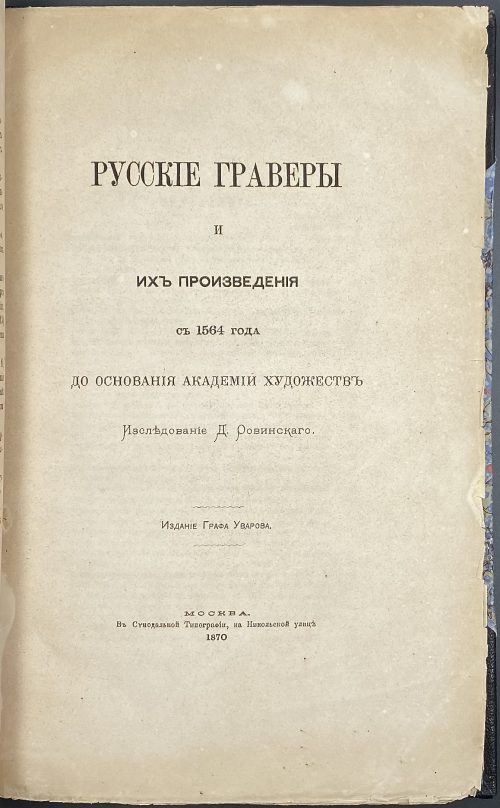 Title: РУССКIЕ ГРАВЕРЫ | И | ИХЪ ПРОИЗВЕДЕНIЯ | СЪ 1564 ГОДА | ДО ОСНОВАНIЯ АКАДЕМIИ ХУДОЖЕСТВЪ. | Изследованiе Д. Ровинскаго. | Изданiе графа Уварова. | МОСКВА. | Въ Сѵнодальной типографiи, на Никольской улицѣ. | 1870. || Pagination: [2] orig. wrapper / advert., [2] t.p. / imp.[i] ii-x, [1] 2-403 [404], [2] orig. wrapper / advert. Collation: 8vo; π6 (incl. t.p.), 1-258 χ2 Binding: Owner’s ½ black morocco over marbled boards, raised bands, gilt-ruled, florets and lettering in compartments, blue endpapers, uncut, untrimmed, original wrappers preserved. Size: 29.5 x 19 cm
Title: РУССКIЕ ГРАВЕРЫ | И | ИХЪ ПРОИЗВЕДЕНIЯ | СЪ 1564 ГОДА | ДО ОСНОВАНIЯ АКАДЕМIИ ХУДОЖЕСТВЪ. | Изследованiе Д. Ровинскаго. | Изданiе графа Уварова. | МОСКВА. | Въ Сѵнодальной типографiи, на Никольской улицѣ. | 1870. || Pagination: [2] orig. wrapper / advert., [2] t.p. / imp.[i] ii-x, [1] 2-403 [404], [2] orig. wrapper / advert. Collation: 8vo; π6 (incl. t.p.), 1-258 χ2 Binding: Owner’s ½ black morocco over marbled boards, raised bands, gilt-ruled, florets and lettering in compartments, blue endpapers, uncut, untrimmed, original wrappers preserved. Size: 29.5 x 19 cm -
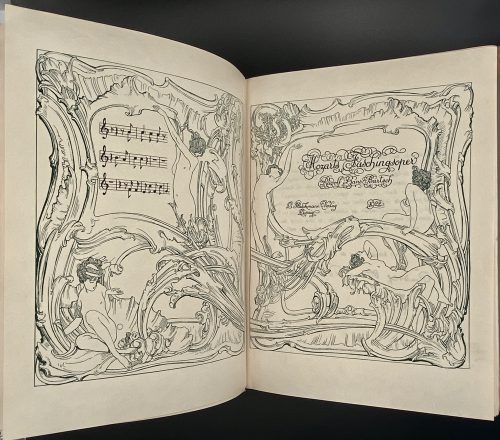 Of the limited edition of 1150 copies, this is №54 (on Japan paper, signed by Bartsch and by von Bayros). Owner's binding imitating quarter-morocco, a red label with gilt lettering to spine (possibly by Ms Hunt, who was an amateur bookbinder). Bookplate on front pastedown: "Ex libris Rachel McMasters Miller Hunt | S. B. Hill Dec 1913 | A.J. Downey Sc." Alfred James Downey (1882-1944). Rachel McMasters Miller Hunt (1882-1963). Sarah B. Hill had done lettering for Ms Hunt. On back pastedown: Stamp "Hunt Libraries CMU" and sticker "Gotham Book Mart | 128 West 45th street | New York". This is from an edition of Carcassonne:
Of the limited edition of 1150 copies, this is №54 (on Japan paper, signed by Bartsch and by von Bayros). Owner's binding imitating quarter-morocco, a red label with gilt lettering to spine (possibly by Ms Hunt, who was an amateur bookbinder). Bookplate on front pastedown: "Ex libris Rachel McMasters Miller Hunt | S. B. Hill Dec 1913 | A.J. Downey Sc." Alfred James Downey (1882-1944). Rachel McMasters Miller Hunt (1882-1963). Sarah B. Hill had done lettering for Ms Hunt. On back pastedown: Stamp "Hunt Libraries CMU" and sticker "Gotham Book Mart | 128 West 45th street | New York". This is from an edition of Carcassonne:
-
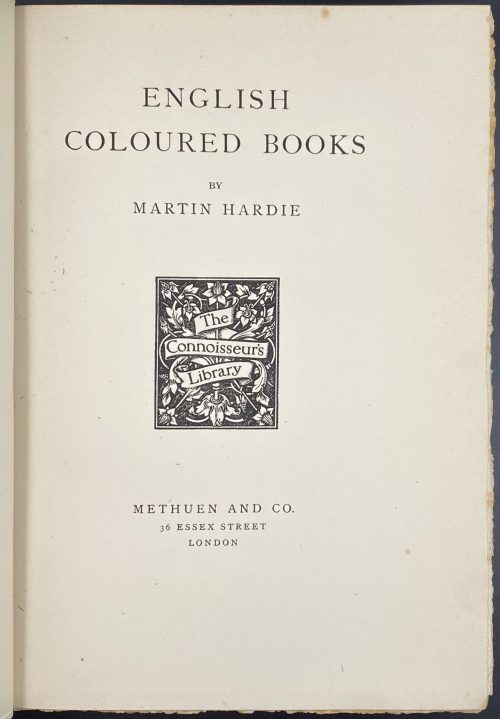 Half-title: THE CONNOISSEURS LIBRARY | GENERAL EDITOR : CYRIL DAVENPORT | […] | ENGLISH COLOURED BOOKS || Title: ENGLISH | COLOURED BOOKS | BY | MARTIN HARDIE | [device: THE CONNOISSEURS LIBRARY] | METHUEN AND CO. | 36 ESSEX STREET | LONDON || Dedication: TO MY WIFE | LOVE’S LABOUR : LOVE’S GIFT Pagination: ffl [i, ii] – h.t. / blank, [2] – blank / frontis. In colour, [iii, iv] – t.p. / First Published in 1906, [v, vi] – dedication / blank, vii-xxiv; 1-339 [340] bfl; 27 sheets of plates, colour and b/w. Collation: 8vo; a8 b4 A-X8 Y2. Binding: Hardcover, 26.3 x 19 x 5.7 cm; red cloth, blind-stamped with repeated fleuron, gilt floral designs and lettering in the frame to front cover, elaborate gilt floral design and lettering to spine; top margin gilt, other untrimmed, some pages uncut; plates w/guards. Printed on laid paper. Printed in Scotland by T. and A. Constable, at the Edinburgh university press. Contributors: Martin Hardie (British, 1875 – 1952) – Author Cyril Davenport (British, 1848 – 1941) – Editor of the series Sir Algernon Methuen (British, 1856 – 1924) – Publisher Thomas Constable (British, 1812 – 1881); Archibald Constable (British, 1774 – 1827) – Founders of the Publishing House "T. and A. Constable".
Half-title: THE CONNOISSEURS LIBRARY | GENERAL EDITOR : CYRIL DAVENPORT | […] | ENGLISH COLOURED BOOKS || Title: ENGLISH | COLOURED BOOKS | BY | MARTIN HARDIE | [device: THE CONNOISSEURS LIBRARY] | METHUEN AND CO. | 36 ESSEX STREET | LONDON || Dedication: TO MY WIFE | LOVE’S LABOUR : LOVE’S GIFT Pagination: ffl [i, ii] – h.t. / blank, [2] – blank / frontis. In colour, [iii, iv] – t.p. / First Published in 1906, [v, vi] – dedication / blank, vii-xxiv; 1-339 [340] bfl; 27 sheets of plates, colour and b/w. Collation: 8vo; a8 b4 A-X8 Y2. Binding: Hardcover, 26.3 x 19 x 5.7 cm; red cloth, blind-stamped with repeated fleuron, gilt floral designs and lettering in the frame to front cover, elaborate gilt floral design and lettering to spine; top margin gilt, other untrimmed, some pages uncut; plates w/guards. Printed on laid paper. Printed in Scotland by T. and A. Constable, at the Edinburgh university press. Contributors: Martin Hardie (British, 1875 – 1952) – Author Cyril Davenport (British, 1848 – 1941) – Editor of the series Sir Algernon Methuen (British, 1856 – 1924) – Publisher Thomas Constable (British, 1812 – 1881); Archibald Constable (British, 1774 – 1827) – Founders of the Publishing House "T. and A. Constable". -
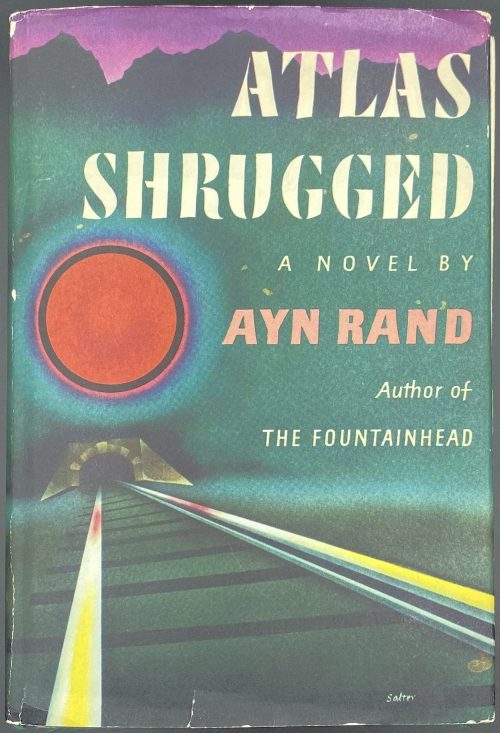 ATLAS | SHRUGGED | AYN RAND | {Publisher's device} | RANDOM HOUSE | NEW YORK || Pagination: [2] - h.t. / advert., [2] – t.p. / colophon, [2] – dedication / blank, [2] – contents / cont., [1, 2] ¬ f.t. / blank, [3] 4-1168 [1169] blank, [1170/71] about the author [1172] blank, two blank leaves. Original green cloth with gilt lettering, black label with gilt lettering and publisher device to spine; top margin green, lateral margin untrimmed. Stated first edition, first printing. Original dust jacket with $6.95 printed price and 10/57 code present on the front flap.
ATLAS | SHRUGGED | AYN RAND | {Publisher's device} | RANDOM HOUSE | NEW YORK || Pagination: [2] - h.t. / advert., [2] – t.p. / colophon, [2] – dedication / blank, [2] – contents / cont., [1, 2] ¬ f.t. / blank, [3] 4-1168 [1169] blank, [1170/71] about the author [1172] blank, two blank leaves. Original green cloth with gilt lettering, black label with gilt lettering and publisher device to spine; top margin green, lateral margin untrimmed. Stated first edition, first printing. Original dust jacket with $6.95 printed price and 10/57 code present on the front flap. -
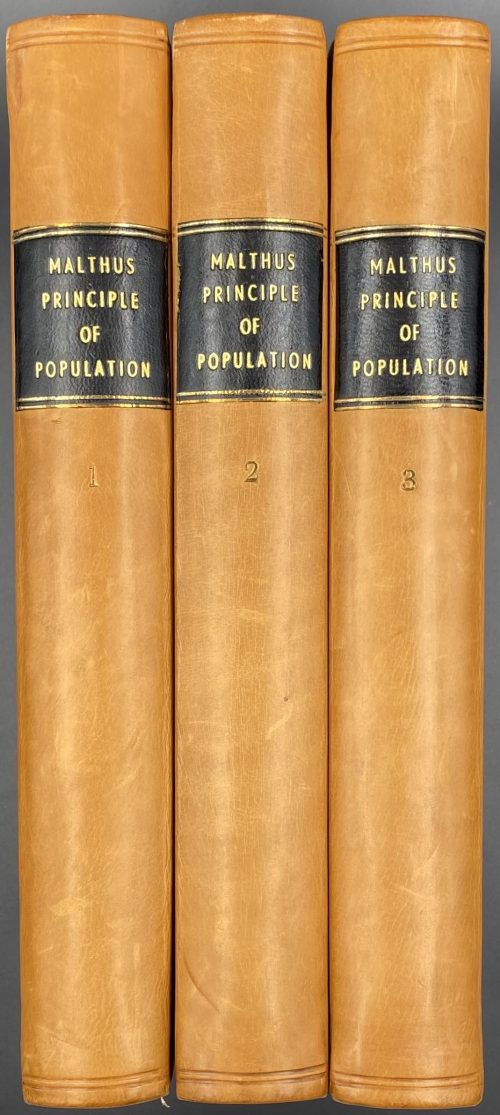 Title: AN ESSAY | ON THE | PRINCIPLE OF POPULATION; | OR, | A VIEW OF ITS PAST AND PRESENT EFFECTS | ON | HUMAN HAPPINESS; | WITH | AN INQUIRY INTO OUR PROSPECTS RESPECTING THE FUTURE | REMOVAL OR MITIGATION OF THE EVILS WHICH | IT OCCASIONS | BY T. R. MALTHUS, A. M. | Late Fellow of Jesus College, Cambridge, and Professor of History and Political Economy in the East-India College, Hertfordshire. | IN THREE VOLUMES. | VOL. I. [or II. or III.] | THE FIFTH EDITION, | WITH IMPORTANT ADDITIONS. | LONDON: | JOHN MURRAY, ALBEMARLE-STREET. | 1817. || Pagination and collation: Vol. 1: ffl, [i, ii] – t. p. / imprint., [iii] iv-xvi, [1] 2-496, bfl; A-Z8 2A-2I8. Vol. 2: ffl, [i, ii] – t. p. / imprint., [iii]-iv – contents, [1]-2-507 [508], bfl; [A]2 B-Z8 2A-2I8 2K6. Vol. 3: ffl, [i, ii] – t. p. / imprint., [iii]-iv – contents, [1]-2-500, bfl; [A]2 B-Z8 2A-2I8 2K2. Binding: Three volumes printed on wove paper, uniformly bound in quarter brown polished calf, blind-ruled, black label, ruled and lettered in gilt to spine, green buckram boards; 22.2 x 13.5 cm. Edition: 5th edition, corrected with a new preface, an updated appendix of Malthus’ responses to his critics, and addition of several chapters to the whole: on France, England, and on the poor laws. Lifetime edition. Ref.: Einaudi 3670; Goldsmiths’ 21761; Kress B.6974; Mattioli 2210. Printed by W. Clowes: William Clowes Ltd. (London). Clowes, William (British, 1779 – 1847). Malthus, Thomas Robert (British, 1766 – 1834). Murray, John (British, 1737 – 1793) Murray, John II (British, 1778 – 1843) John Murray (publishing house)
Title: AN ESSAY | ON THE | PRINCIPLE OF POPULATION; | OR, | A VIEW OF ITS PAST AND PRESENT EFFECTS | ON | HUMAN HAPPINESS; | WITH | AN INQUIRY INTO OUR PROSPECTS RESPECTING THE FUTURE | REMOVAL OR MITIGATION OF THE EVILS WHICH | IT OCCASIONS | BY T. R. MALTHUS, A. M. | Late Fellow of Jesus College, Cambridge, and Professor of History and Political Economy in the East-India College, Hertfordshire. | IN THREE VOLUMES. | VOL. I. [or II. or III.] | THE FIFTH EDITION, | WITH IMPORTANT ADDITIONS. | LONDON: | JOHN MURRAY, ALBEMARLE-STREET. | 1817. || Pagination and collation: Vol. 1: ffl, [i, ii] – t. p. / imprint., [iii] iv-xvi, [1] 2-496, bfl; A-Z8 2A-2I8. Vol. 2: ffl, [i, ii] – t. p. / imprint., [iii]-iv – contents, [1]-2-507 [508], bfl; [A]2 B-Z8 2A-2I8 2K6. Vol. 3: ffl, [i, ii] – t. p. / imprint., [iii]-iv – contents, [1]-2-500, bfl; [A]2 B-Z8 2A-2I8 2K2. Binding: Three volumes printed on wove paper, uniformly bound in quarter brown polished calf, blind-ruled, black label, ruled and lettered in gilt to spine, green buckram boards; 22.2 x 13.5 cm. Edition: 5th edition, corrected with a new preface, an updated appendix of Malthus’ responses to his critics, and addition of several chapters to the whole: on France, England, and on the poor laws. Lifetime edition. Ref.: Einaudi 3670; Goldsmiths’ 21761; Kress B.6974; Mattioli 2210. Printed by W. Clowes: William Clowes Ltd. (London). Clowes, William (British, 1779 – 1847). Malthus, Thomas Robert (British, 1766 – 1834). Murray, John (British, 1737 – 1793) Murray, John II (British, 1778 – 1843) John Murray (publishing house) -
![Bayros Zeichnungen. — Gala Verlag, Hamburg fur Fourier Verlag GmbH, Wiesbaden, 1987. — pp. 207. — 233 illustrations, essay by Wilhelm M. Busch. [Franz von Bayros Drawings].](https://varshavskycollection.com/wp-content/uploads/2021/02/LIB-2245.2019-a-500x749.jpeg) 26 x 18 cm, black cloth, white lettering to cover and spine, pictorial DJ, pp. [1-4] 5-207 [208 colophon], 233 b/w illustrations; essay by Wilhelm M. Busch.
26 x 18 cm, black cloth, white lettering to cover and spine, pictorial DJ, pp. [1-4] 5-207 [208 colophon], 233 b/w illustrations; essay by Wilhelm M. Busch. -
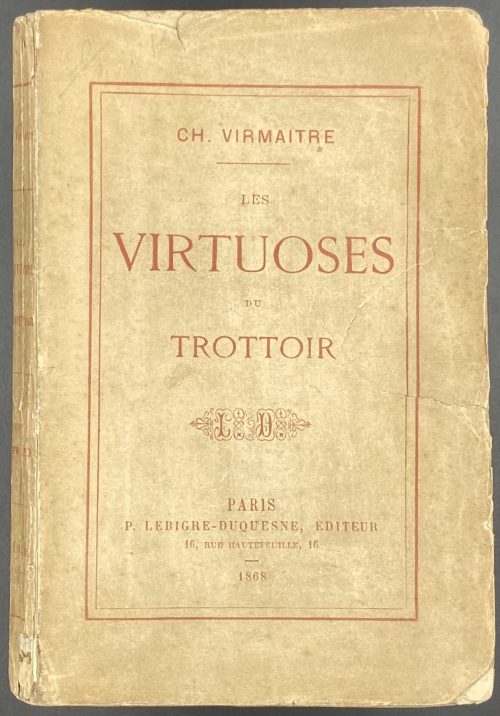 Cover: Ch. Virmaitre | LES | VIRTUOSES | DU | TROTTOIR | {publisher’s device} | PARIS | P. LEBIGRE-DUQUESNE, ÉDITEUR | 16, RUE HAUTEFEUILLE, 16 | 1868 || Title: Similar. Imprint: De Rouge Frères, Dunon et Fresné (Paris). Pagination: [1-7] 8-161 [162], [2] – table, [2] – advert., [14]; 90 leaves total; publisher’s cream wrappers with red lettering in double frame. Collation: 12mo in 6th; [1]-136, 1412. Charles Virmaître (French, 1835 – 1903).
Cover: Ch. Virmaitre | LES | VIRTUOSES | DU | TROTTOIR | {publisher’s device} | PARIS | P. LEBIGRE-DUQUESNE, ÉDITEUR | 16, RUE HAUTEFEUILLE, 16 | 1868 || Title: Similar. Imprint: De Rouge Frères, Dunon et Fresné (Paris). Pagination: [1-7] 8-161 [162], [2] – table, [2] – advert., [14]; 90 leaves total; publisher’s cream wrappers with red lettering in double frame. Collation: 12mo in 6th; [1]-136, 1412. Charles Virmaître (French, 1835 – 1903).



